-
10 Tips to Kickstart Your Spring Cleaning in 2023
Spring is just around the corner and with the warmer weather comes a fresh necessity for a clean and tidy home. The changing seasons bring new life and new opportunities to us all, and unfortunately this almost means allergies. But before you find yourself becoming a sniffling and drowsy mess, its time for some cleaning.
There is no time like the present to knock out your annual spring cleaning checklist and do some serious decluttering around the house. To help you get rolling and stay motivated, we’ve compiled a few of our favorite tips and tricks so that you’ll have an arsenal of cleaning hacks at your disposal for this year’s spring cleaning around your home.
Related: The Ultimate Spring Cleaning Checklist (Printable Infographic)
How to Prep for Spring Cleaning
In order to make sure you’re fully prepared and ready to get down to business, you should make sure you have everything you’ll need. From products to equipment, let’s take a second to outline what you’ll want to have on hand for this cleaning project. Here is a general checklist of supplies you’ll need:
- Rubber gloves
- Microfiber cloths
- Sponges and brushes
- Duster tools
- Garbage bags
- Vacuum and attachments
- Wet and or dry mop
- Squeegee
- Glass cleaner
- Disinfectant
- Multi-surface cleaner
- Dusting spray
- Appliance cleaner
- White vinegar
- Baking soda
- Optional: Boxes for donations
You may not need every single one of these products and tools, or you may need them all and more. Every home is different and won’t be cleaned in the same way, which means that there is no right or wrong way to fully clean your home. However you clean your home is up to you, but we like to give the best advice we can when it comes to those who may be newer at keeping up with cleaning and upkeep around the house.
1. Plan Ahead
Before you jump into your spring cleaning, take a moment to wander your home and make a plan. Whether that means customizing a checklist for each room or sitting down and delegating tasks to everyone in the home, going in with a rough idea of what needs to be done can make a difference. If you live with multiple people, having a plan can keep everyone focused and on task, and can even make the cleaning process fun if you turn it into a game of sorts. Not only will this help you stay on task, it can help you to stay motivated as you cross more and more of your cleaning task list.
2. Start Simple
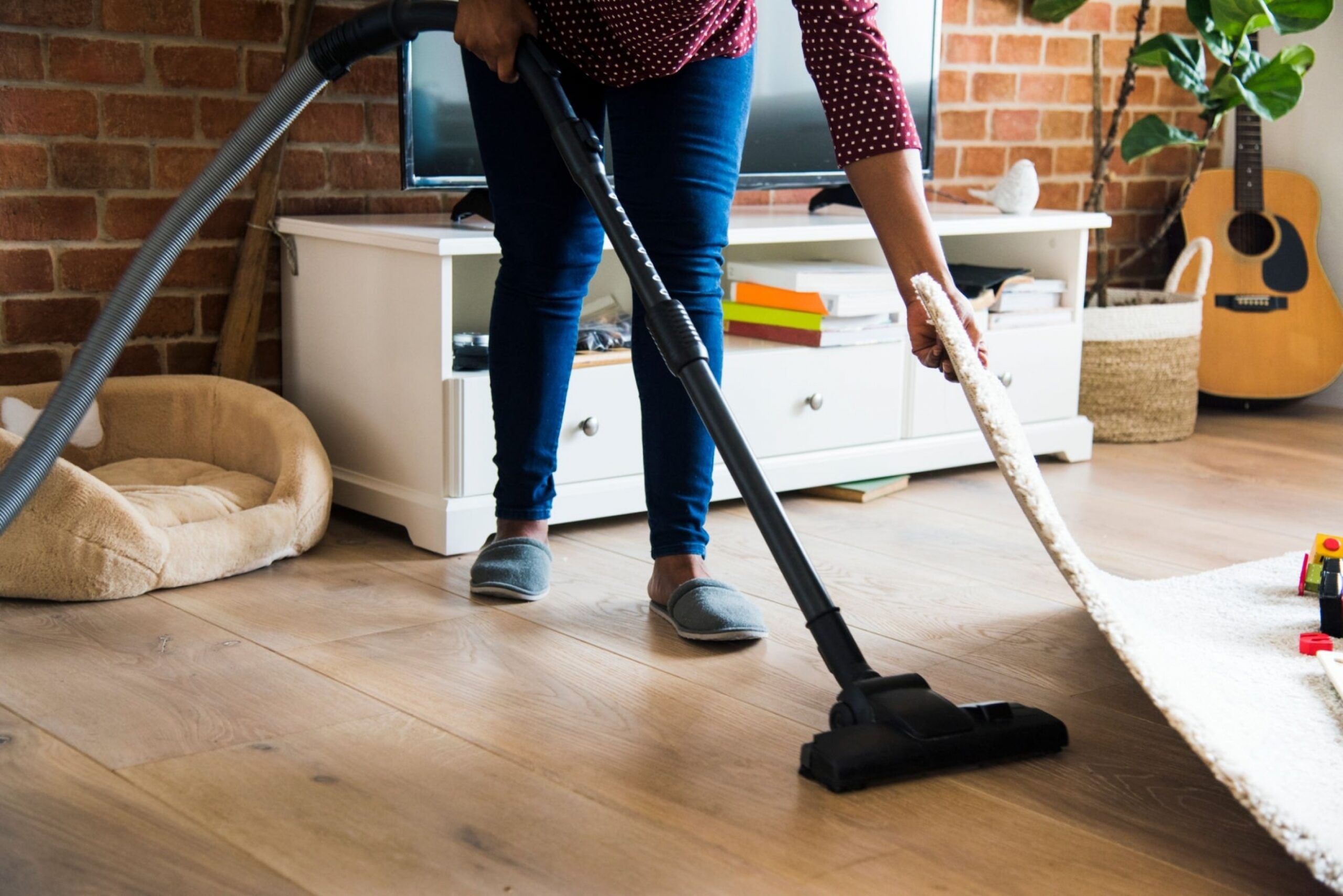
We suggest starting the process within the kitchen or the bathrooms, but whichever room of your home you start cleaning is up to you. It is a good idea to also start by tackling the more obvious tasks around the home as a whole before focusing on the larger and more tedious projects. This can be dusting, vacuuming, sweeping, picking up laundry, wiping up crumbs and debris, or staring a load of laundry to be switched out for another round later. Starting with the simplest and most obvious tasks will make more of the deeper cleaning projects more identifiable and accessible.
3 .Declutter as You Clean
Spring cleaning is an excellent time to do some extensive and ruthless decluttering. Each room can contain numerous expired and perishable items and clothing that no longer fits or is stained and damaged. Now is the time to go through your drawers, closets, pantry, and refrigerator to make sure anything that no longer serves a purpose gets the boot. There’s no better way to bring in warmer weather than with a clear space.
4. Work Top to Bottom
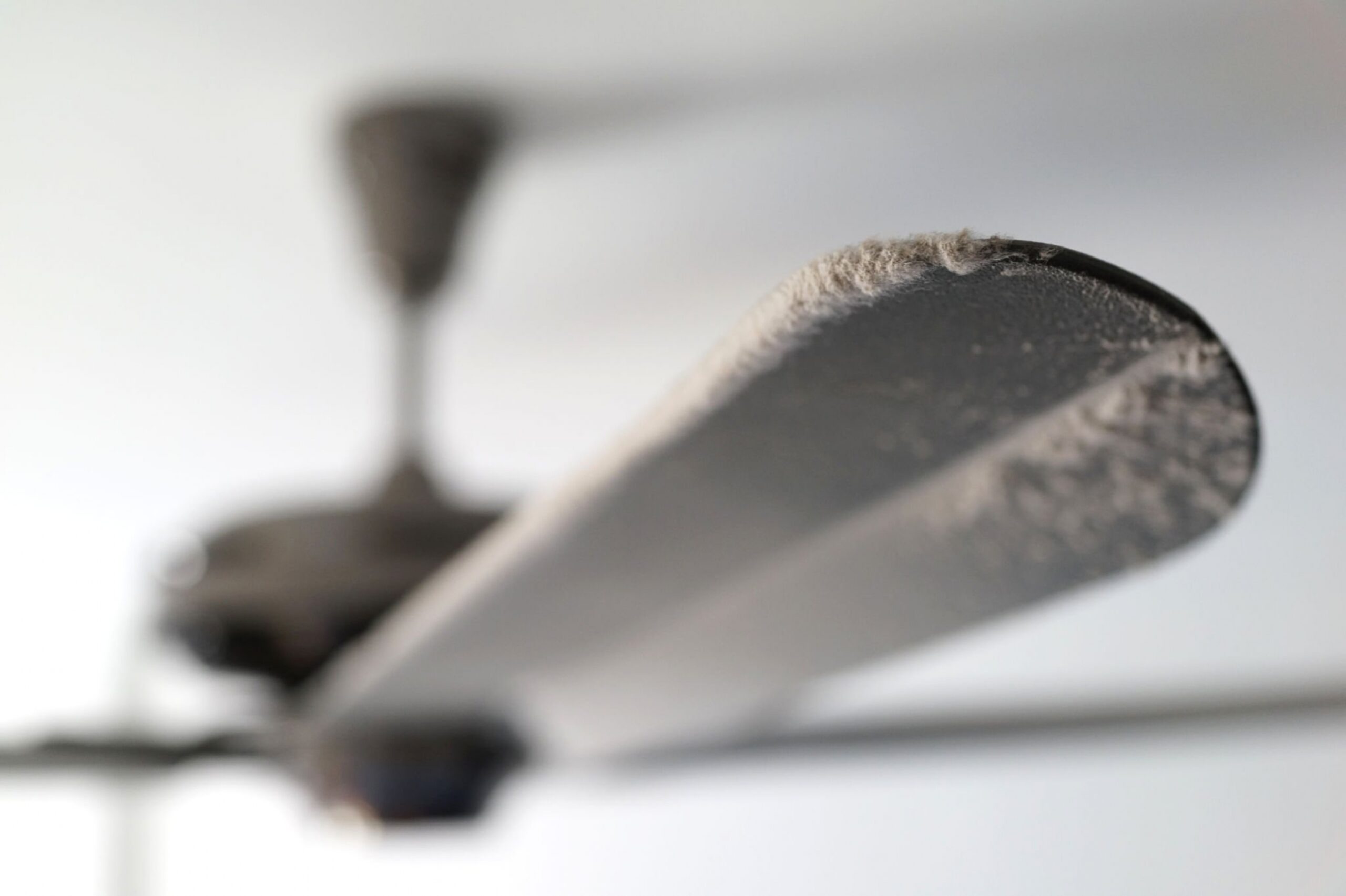
When cleaning, the best rule of thumb is to clean from high to low, that means starting upstairs and working down as well as starting in each room by dusting from ceiling to floor. By cleaning from top to bottom, you are able to ensure that no dust is left on any surface in the room. This is also a great way to save time and effort during the cleaning process and work efficiently.
5. Bust Through the Dust
One of the key tasks in every room is dusting. The best way to control the buildup of dust and other allergens in your home is with regular cleaning, but sometimes it can be left to accumulate. Now is the time to be thorough and detail-oriented in each room to make sure every surface is clean and clear of dust.
6. Freshen Up the Fridge
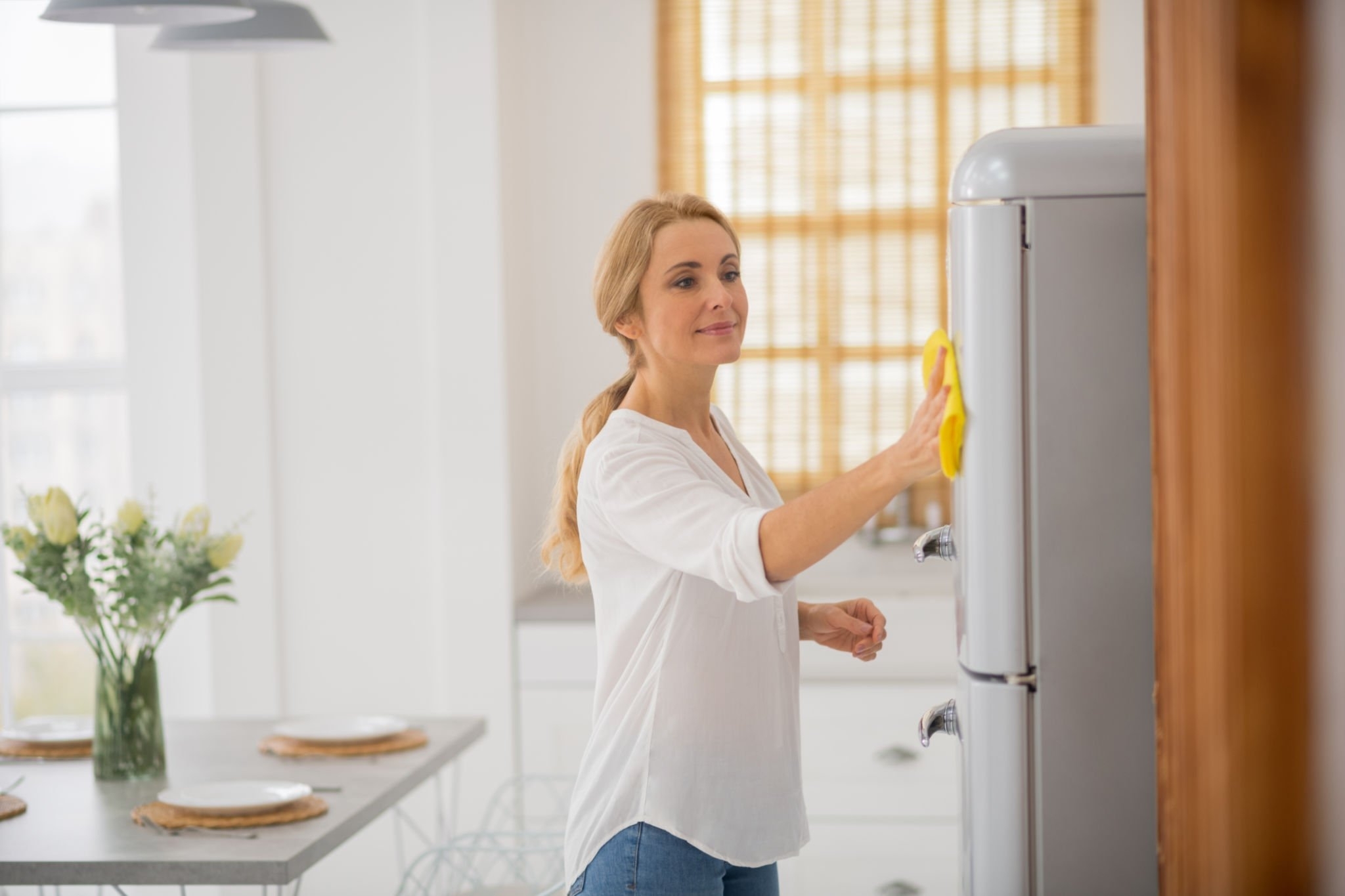
Your refrigerator is in constant use and can very easily become cluttered with leftovers and expired foods. Spring cleaning is the perfect time to deep clean and organize your fridge and freezer. Take an hour or so to empty things out and really scrub, deodorize, and and sanitize each self and drawer. It’s important to keep the spaces in which food is kept clean and clear of bacteria so that you and your family is safe and healthy.
7. Clear the Junk Drawers
Every home has a junk drawer, a black hole that seems to contain the most random assortment of items from around the house. Sometimes junk drawers can become junk rooms, and that’s okay. Now is the best time to tackle those problematic spaces head on by emptying them out and making sure everything is returned to its proper place in your home, thrown out, and sold or donated. Show that junk drawer or room who’s boss!
8. Don’t Forget the Details
Once you’ve cleared and cleaned the surfaces and appliances around the house, it would be a good idea to check over the more tedious cleaning tasks. This can include:
- Cleaning rugs and doormats
- Cleaning the inside and outside of windows
- Wiping down walls, baseboards, and trim
- Cleaning and sanitizing toys
- Cleaning outdoor furniture
- Cleaning and deodorizing sinks
- Sanitizing cutting boards
- Cleaning tiles and grout
- Replacing or cleaning HVAC air filters
- Cleaning or repairing your cleaning tools and equipment
9. Take Time to Reorganize
While you’re taking time to be thorough and ruthless in your spring cleaning and decluttering, you can also take this time to reorganize. Whether this means investing in a more functional system within your closets and pantry or just sorting items and clothing in a more efficient way, take this as an opportunity! There is no better time to fully upgrade your home for a more efficient life.
10. Disinfect Deeper Than Ever
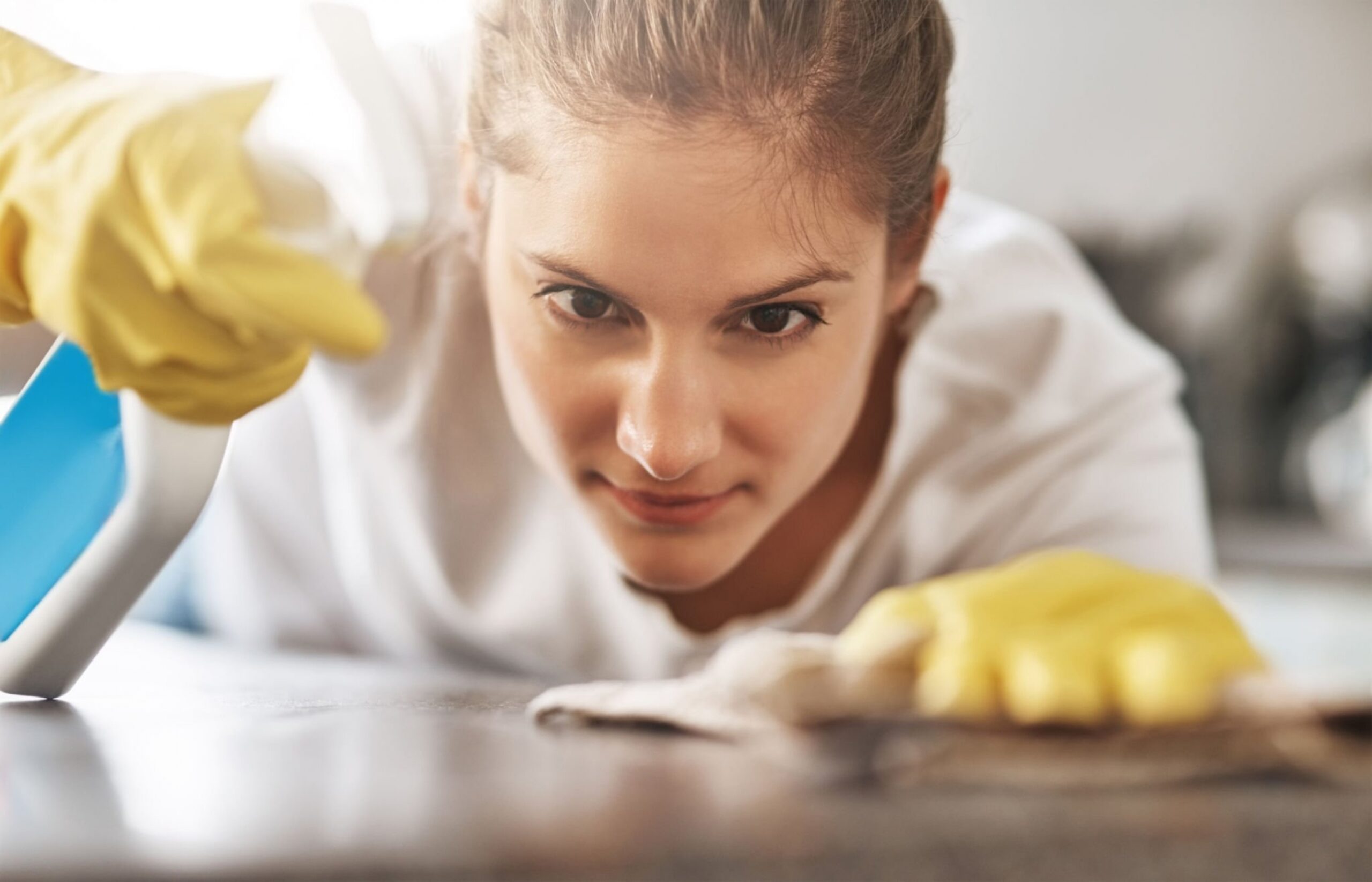
Disinfecting around the home is one of the most important tasks when cleaning. Even if its already a part of your regular cleaning routine, you should always take time to disinfect the surfaces around your house. Make sure to give extra time and attention to the high-touch and high-traffic surfaces like remotes, door handles, and light switches when you disinfect so that you know your family will be safe and healthy for the warmer months.
How to Stay Motivated to Spring Clean
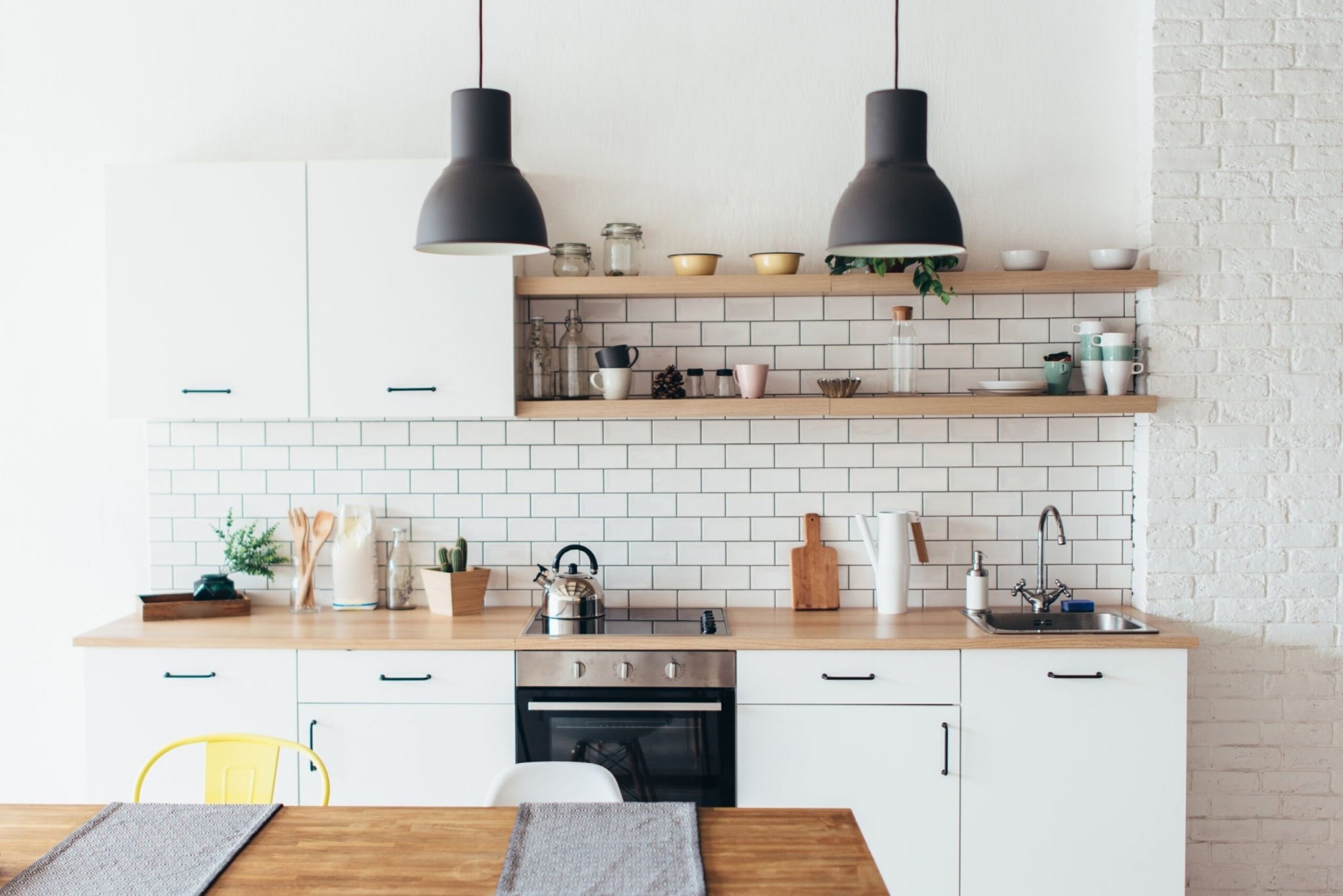
If you’ve read through the tips and tricks and find yourself more overwhelmed than when you started, take a breath and don’t stress. Remember that we said that there is no right or wrong way to clean your home and that however you choose to clean your space is up to you. We know cleaning the whole house can be a daunting task, so allow us to offer some motivation and a few tips to help get you started:
- Remember to clean at your own speed, it isn’t a race and you don’t have to exhaust yourself to accomplish everything in one day. You can create a schedule and set goals for yourself and anyone else in the home to help you to start and finish the job at hand. Find what works for you and stick with it until the work is done.
- Brighten up the space and your mood before you get started and as you work. Open up the windows to let in more natural light and turn on your favorite music to hype yourself up. You’ll find yourself working more efficiently and with more energy when you are in a sunny and energizing environment.
- Browse social media for some inspiration and put yourself in a mindset that is motivated to clean and see results. Cleaning can be a great way to reduce stress and be mindful of the items you bring in and keep in your home, so take some time to make a mental note of why you are cleaning and what your end goal is.
No matter if you’ve been cleaning for years or if this will be your first round of cleaning in a new space, spring cleaning is the best time to jumpstart the weekly and daily cleaning routines in your home. What kinds of spring cleaning tips and tricks do you use around your home? Share your advice in the comments, we’d love to hear from you!
If spring cleaning is simply not your forte but you’re in desperate need for some help keeping up with your home, we’ve got your back. You can check out Cleanzen’s Spring Cleaning services to find out how our services can help you around your home. Contact us today to find out what other services we can offer your home or business.
The post 10 Tips to Kickstart Your Spring Cleaning in 2023 appeared first on Cleanzen.
from Cleanzen https://cleanzen.com/blog/spring-cleaning-tips-for-2023/
via IFTTTfrom Cleanzen Cleaning Services https://cleanzencleaningservices0.blogspot.com/2023/03/10-tips-to-kickstart-your-spring.html
via IFTTTfrom Gabriela Bragg https://gabrielabragg.blogspot.com/2023/03/10-tips-to-kickstart-your-spring.html
via IFTTT -
A DIY Guide to Removing Stains from Wood Floors
Hardwood floors look beautiful in almost every home, but no matter how much you clean them some spots just refuse to be clean. Stains can wind up on any floor, even wood, so it is best to be prepared when you inevitably find a few. To help, we’ve created this DIY guide to assist you in keeping your floors clean and stain-free.
Type of Stains

Before you try to remove any stains from your wood floors, you should probably be aware of the kind of stain you’ll be removing. These are the most common kinds of stains you may find on your wood floors and furniture, we’ll get into how to treat and remove them later.
1. White Water Marks & Rings
These stains usually form on wood floors and furniture when any wet or damp cup, glass, or fabric is left on the surface of the wood. The stains appear white or lighter in color when the moisture mixes with the finish or wax on the wood.
2. Dark Water Stains
These stains form from moisture or dampness, similar to the formation of lighter stains, or from oxidation on the wood. The darkness of the stain indicates that moisture has penetrated deeper into the wood and will likely require more care to remove it.
3. Heat Stains
When something hot, like a mug or candle, is placed on the surface of the wood it expands. This allows the moisture created by heat and steam to settle deeper within the wood leaving behind light and cloudy discoloration and stains.
DIY Stain Removal

Now that you have a rough idea of the kind of stains you’ll be dealing with, we can discuss removal. There are many different ways to remove the various stains we mentioned, but not every method works for every stain. Here are our best recommendations for removing stains from wood floors:
Mayonnaise
One of the simplest ways to treat darker stains is with mayonnaise, no matter how much you love or hate it. Here’s what to do:
- Use a clean cloth to wipe a small amount of mayo in a hidden area to test before treating the stain itself. If there’s discoloration from this test, we suggest trying a different method.
- If the mayo doesn’t leave any discoloration, wipe a generous amount directly on and around the stained area you’re trying to treat.
- Allow the mayo to sit on the stain for a few hours, or overnight for best results, reapply if it dries up too quickly.
- In the morning, use a fresh and damp cloth to remove the mayo and check the state of the stain. Note: If there is still discoloration from a dried or old stain, you may have to try a different method.
Toothpaste
Toothpaste can be a surprising stain removal method, but it works we promise. This works best on lighter water stains or stains that have dried up, but remember to use a non-whitening and non-gel variety for the best results. Here’s what to do:
- Squeeze a small bit of toothpaste onto a soft and clean cloth.
- Lightly buff the toothpaste onto the surface of the stained wood, making sure to follow the grain. Note: Don’t rub the stained wood too hard with the toothpaste or you may worsen the appearance of the stain or damage the finish on the wood.
- Allow the toothpaste to sit on the stain for about a minute before removing it with a lightly dampened cloth.
- Take a moment to assess the stain and repeat the process if necessary.
Clothing Iron
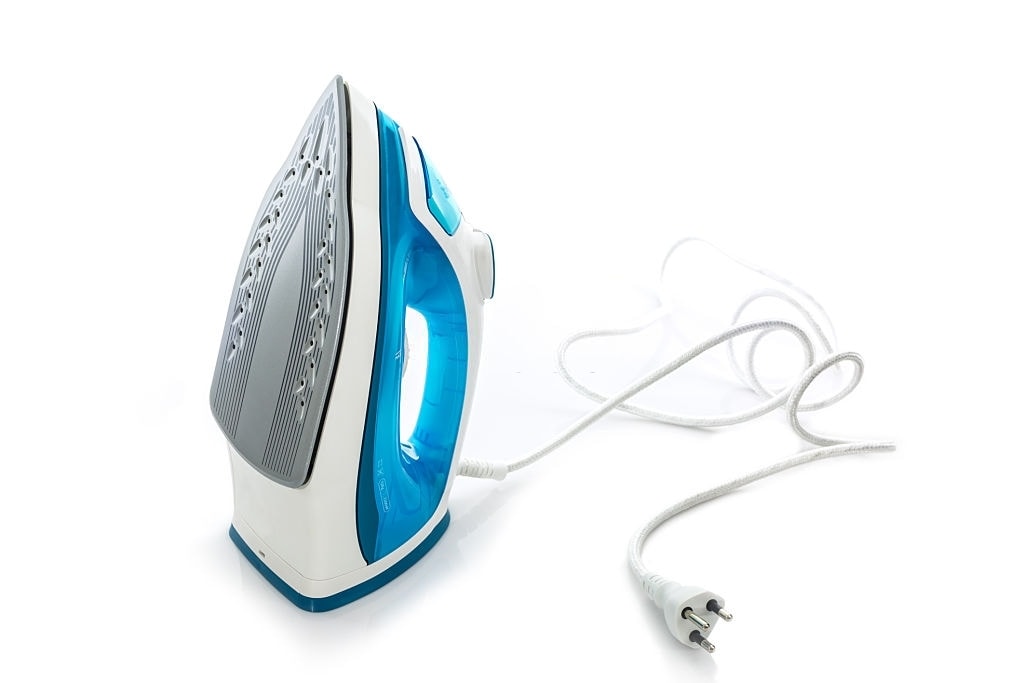
If you catch a fresh or still damp water stain on your wood floors, you’re in luck but you’ll want to move quickly to make sure it doesn’t set in. One way to remove the moisture is by using heat from and iron, or hairdryer, to evaporate it. You’ll need to be careful not to damage the wood in the process, so follow these instructions carefully:
- Make sure there is no water within the iron, you don’t need any steam releasing during this process.
- Place a cotton rag or old t-shirt over the stain.
- Turn on the iron and make sure it is set to the lowest heat setting.
- Pass the iron gently over the surface of the cloth or t-shirt for a few seconds, making sure to check on the stain frequently.
- Alternatively, turn on the hairdryer to the lowest heat setting and wave it directly over the stain, no cotton barrier needed, for a few seconds at a time. Note: For both the iron and the hairdryer, be careful not to allow the heat to linger on the wood for more than a few seconds so as to not further damage the wood and allow moisture deeper into the pores.
- Check the state of the stain frequently and allow the surface of the wood to cool before attempting the method again.
White Vinegar
For darker stains on wood floors, we highly recommend white vinegar. The acidity makes this both effective and safe to use on wooden floors, plus its a great disinfectant. Here’s the best way to utilize vinegar on dark stains:
- For fresher and lighter stains, we suggest diluting your white vinegar in some water before treating the stain.
- For darker and more set in stains, you can use undiluted white vinegar to treat the stain.
- Allow a few cloths or paper towels, depending on what you have available or prefer, to soak in the vinegar or vinegar solution.
- Place the cloths or paper towels directly over the stained wood and allow them to sit for about half an hour.
- Remove the cloths or paper towels and use a water dampened cloth to wipe the surface of the stain before leaving it to dry for another half an hour.
- Once the effected area is completely dry, you can check for any residual staining and repeat the process if you need to.
Hydrogen Peroxide
Like vinegar, hydrogen peroxide is great at treating darker stains on wood. However, when you use this method make sure that you only use 3% hydrogen peroxide as higher concentrations will permanently discolor and ruin wood. Here is how to properly use hydrogen peroxide to treat darker stains on wood:
- Before treating the actual stain, use a cloth dampened with hydrogen peroxide to wipe a small and hidden area to test for discoloration.
- Gently press a soft cloth dampened with a generous amount of hydrogen peroxide directly onto the stained wood.
- Rewet the cloth if necessary, then place the cloth on the stain for a few hours or overnight.
- Remove the cloth and check the stain in the morning, then use a lightly water dampened cloth to wipe the surface of the wood and allow it to fully dry.
- Once the area is completely dry, you can repeat the method if you need to until the stain is fully removed.
Toothpaste & Baking Soda
One of the best ways to treat a heat stain on wood floors is by mixing toothpaste and baking soda. Here’s what to do:
- Start by using a damp cloth to wipe the surface of the wood and then allowing the area to dry completely.
- Using a non-whitening and non-gel toothpaste, squeeze a small amount into a small bowl or onto a plate and mix in a generous amount of baking soda.
- Use a soft cloth to rub the paste directly onto the stain and allow the paste to sit for about 10 minutes.
- Use a fresh damp cloth to wipe away the paste and clean the surface of the wood.
- Allow the area to dry completely before repeating the process if you need to until the stain has faded.
Things to Remember

Wood floors are gorgeous and can really warm up a home, but they can be stained surprisingly easily. There are a few things to keep in mind when managing upkeep and treating any stains you may find:
- First and foremost, act as fast as possible when cleaning up any liquid spills on wood floors. The longer moisture sits on the surface of wood, the harder it is to clean up without the risk of staining.
- When cleaning up stains, do your best to avoid using anything abrasive to scrub the wood floor. Using anything like steel wool or hard bristle brushes risks damaging or even stripping the finish from the wood.
- Don’t be afraid to sand and refinish an area if the staining is bad enough. While it may not be preferable, it can be more effective and less expensive than calling in a professional.
- Despite our previous suggestion, calling professionals when all else fails is always a safe choice. Especially if you don’t have mush experience or knowledge when it comes to wood floors.
FAQs
What not to use on hardwood floors?
When cleaning hardwood floors, avoid using any harsh cleaners like ammonia or alkaline products as these can dull and scratch the finish on the wood.
Does baking soda remove stains from hardwood floors?
Baking soda should only be used in small amounts combined with other products to treat stains on wood floors. It should never be used to clean wood floors on its own or combined with vinegar.
Can you use dishwashing liquid to clean hardwood floors?
Dishwashing liquid is mild enough to be safe to use on hardwood floors and effective enough to be recommended by professionals. You can add a few tablespoons of dishsoap to a gallon of water to clean and mop your floors.
Is it okay to use hot water on wood floors?
If you are looking to clean and mop your wood floors, you should not use hot water to do so. Always use warm water, not hot, when mopping and never allow water to stand on hardwood floors or you risk extensively ruining the finish of the wood and the wood itself.

Do you have any stain fighting tips that have worked for your wood floors? Have you made any mistakes and want to make sure no one else faces similar issues? Share your experiences and tips in the comments below, we’d love to hear from you!
If you’re looking for some help when it comes to keeping your wood floors looking amazing and stain-free, call us! Our maid services in Miami could be just what you need, so check out our website and find out what kind of services we can offer you.
The post A DIY Guide to Removing Stains from Wood Floors appeared first on Cleanzen.
from Cleanzen https://cleanzen.com/blog/how-to-remove-stains-from-wood-floors/
via IFTTTfrom Cleanzen Cleaning Services https://cleanzencleaningservices0.blogspot.com/2023/03/a-diy-guide-to-removing-stains-from.html
via IFTTTfrom Gabriela Bragg https://gabrielabragg.blogspot.com/2023/03/a-diy-guide-to-removing-stains-from.html
via IFTTT -
Grubby TV Screen? Here’s How to Fix It!
Our TVs are used almost as much as, if not more than, our smartphones and tablets. With regular use comes regular messes and dust buildup on and around the TV screen, especially with all the many sports events and reality TV we’ve been watching.
No matter what model of TV sits in your home, old or new, the screen will need some cleaning and dusting on a regular basis. We’ve put together our best tips and tricks for cleaning your TV screen, remotes, and external speakers properly and safely, plus 2 quick household recipes for DIY screen-safe cleaners. Keep reading to find out how you can keep your TV screen clean and streak-free.
Best Cleaning Methods
Before you get started with cleaning your TV screen, you should make sure you have the supplies you’ll need. Here are the basics:
- Microfiber cloths
- A screen-safe cleaning solution
- If you’re curious about what you can use as a cleaning solution, here are 2 quick DIY solutions you can use for your newer model TVs:
- Mix equal amounts of white vinegar and distilled water in a spray bottle.
- Mix together 1 part distilled water with 4 parts 70% rubbing alcohol.
- Note: Do not use a rubbing alcohol of any higher percentage than 70% as they can damage the TV screen.
- If you’re curious about what you can use as a cleaning solution, here are 2 quick DIY solutions you can use for your newer model TVs:
- Rubbing alcohol (for older TVs)
Once you have everything you need and have mixed up your DIY cleaner, its time to get started with the cleaning process.
Flat-Screen Plasma, LED, LCD and OLED TVs

Newer model TVs often have flat and delicate surfaces that require a careful hand and extra care. Here is the best and safest way to clean these more delicate pieces of electronics:
- Make sure the TV is completely turned off and cool before cleaning. You can unplug your device, but it usually isn’t necessary for newer model TVs.
- Use a microfiber cloth to first carefully dust off the surface of the TV screen.
- Spray a small amount of screen-safe cleaner, or one of the DIY cleaners above, onto a fresh, dry microfiber cloth. Do not spray or apply cleaner directly to the TV screen.
- Wipe the cleaner onto the screen in a side-to-side motion and then up and down. Overlapping strokes, not circular motions, are the best way to avoid streaks on shiny TV screens and surfaces.
- Make sure the surface of the TV screen is completely dry and clear before either repeating the cleaning process or plugging it back in and turning it on.
Tube Televisions
Older TVs, like cathode ray tube (CRT) TVs, are also daily easy to clean, but they do require a little extra attention to detail. Here is the proper way to clean older model and tube TVs:
- Turn off and unplug the TV and allow it to cool is it is warm to the touch. Unlike modern TVs, unplugging these TVs is required so make sure your device is not connected to power before you start cleaning it.
- Use a microfiber cloth to dust the surface of the TV screen. You can also take a moment to dust around the device itself.
- Apply a cleaning solution to a fresh microfiber cloth. To clean the surface, you can either use one of the DIY cleaning solutions above or 70% rubbing alcohol on the cloth or as a presoaked wipe if the screen is particularly grubby.
- Note: In a pinch, you can use a very small amount of glass cleaner to clean glass TV screens on older devices only.
- Wipe the cleaning solution onto the screen in back-and-forth then up-and-down strokes. Remember not to use circular motions when cleaning the screen.
- Allow the surface of the TV screen to fully air dry before checking for additional smudges and streaks.
- Once the screen is completely dry, you can repeat the cleaning process if needed. If the screen needs not additional cleaning, simply finish by using a microfiber cloth to buff the surface to remove stray fingerprints or streaks.
Stubborn Spots & Streak Free Cleaning
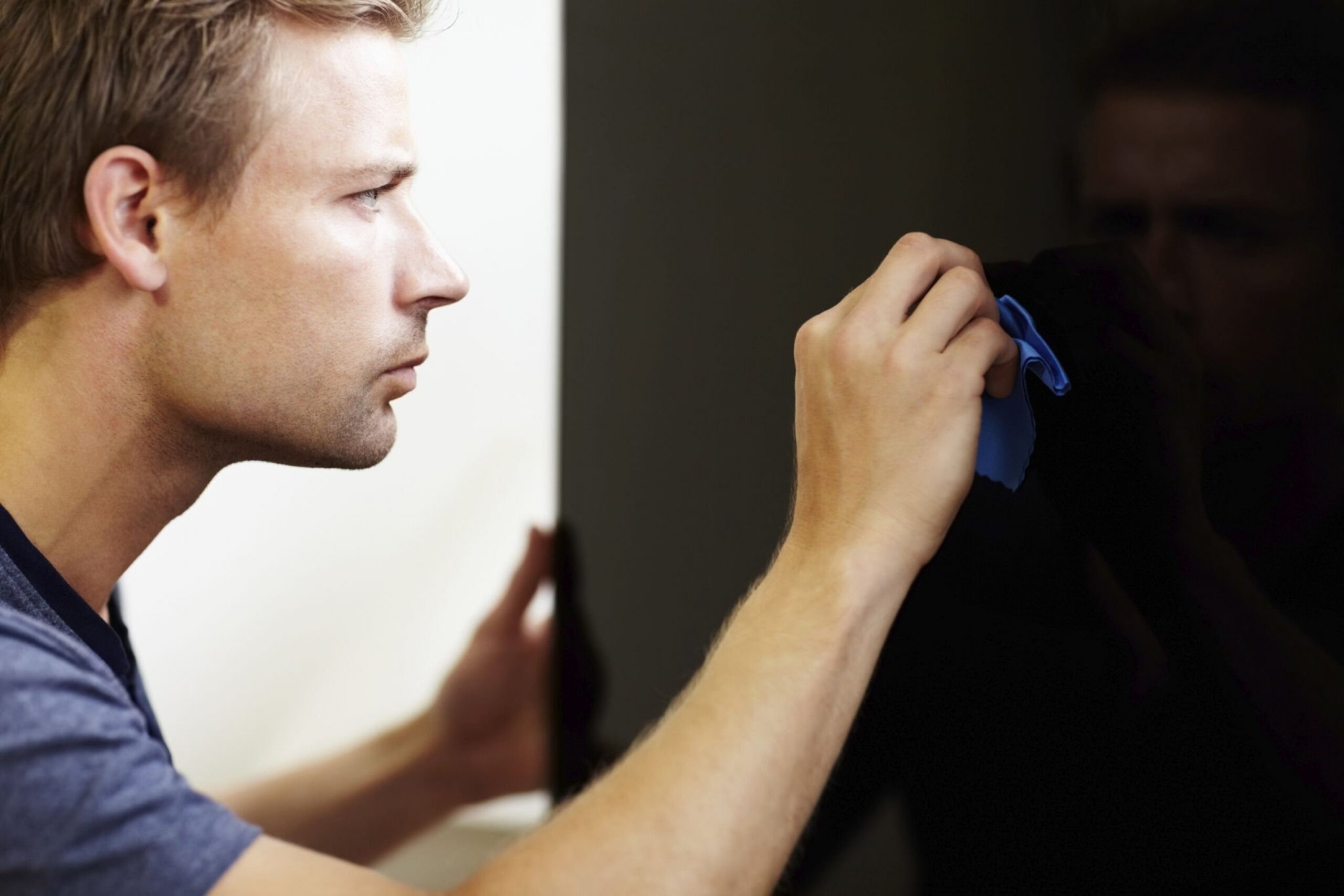
If you find some stubborn fingerprints or sticky spots around your TV screen, that’s okay, life happens. For the best results when treating these stubborn spots, here’s what to do:
- Mix a few drops of mild dish soap in some distilled water, only a very small amount of soap will be needed.
- Dip a microfiber cloth into the soapy water and wring out the excess before using the cloth.
- Use the dampened cloth to gently wipe away the grimy stains or smudges, taking care to not use too much water on the surface.
- Allow the surface to air dry before checking for additional spots or streaks. If you are spot cleaning an older TV screen, you can use a fresh microfiber cloth to buff the surface free of streaks.
Cleaning Remotes & Speakers
If you have extra accessories for your TV like remotes and speakers, you’ll probably want to give those a once over cleaning as well. While they don’t have screens, they’re still sensitive electronics so you’ll have to use care when cleaning them. Here are some best practice cleaning tips for remotes and speakers:
Remotes

Thankfully for everyone, remotes are actually really easy to clean. All you’ll really need is your go-to disinfecting wipes or spray and a cloth. Here’s how to clean your remote without damaging it:
- Take out the batteries from your remote and set them aside.
- Gently tap the remote, button side down, on a table or other flat surface to loosen and dislodge any crumbs or other debris.
- For cleaning, you can either use a pre-soaked disinfectant wipe or a cloth that you can spray disinfectant onto. Make sure the wipe or cloth is not soaked and dripping wet by wringing it out before using it.
- Wipe the disinfectant around the entire surface of the remote, paying particular attention to the spaces between buttons.
- You can use a toothpick or your fingernail to dislodge stubborn debris from under and around the buttons.
- Once the remote has been thoroughly cleaned and disinfected, you can set it aside to completely air dry.
- If you’d like to go the extra mile, you can test the batteries you removed to make sure they’re still good or if they need to be replaced.
- Check that the remote is completely dry and then replace to batteries into the device.
Speakers
If you have set up external speakers for your TV, now is a good time to makes sure they’re clean and dusted. These are pretty sensitive devices, so here is how to properly clean and care for your speakers:
- Before any cleaning or dusting, make sure to check for any cleaning guidelines within the owner’s manual for the speakers. This is always best practices for pieces of sensitive electronics and equipment.
- Unplug or remove the batteries from the speakers so that the devices are not connected to power while you are cleaning them.
- If the fabric covers of the speakers can be removed, go ahead and take those off to be cleaned separately.
- We recommend using your vacuum’s upholstery attachment to carefully clean and dust the fabric covers.
- If the fabric covers cannot be removed, you can use a lint roller or your vacuum hose with the upholstery attachment to remove any dust and debris from the surface of the speakers.
- If your speakers are solid and do not have a fabric cover, you can use a lightly moistened microfiber cloth to dust and clean the surface of the device.
- Allow the speakers to dry if necessary before replacing the removed batteries or plugging the devices back in.
Extra Tips for Cleaning TV Screens
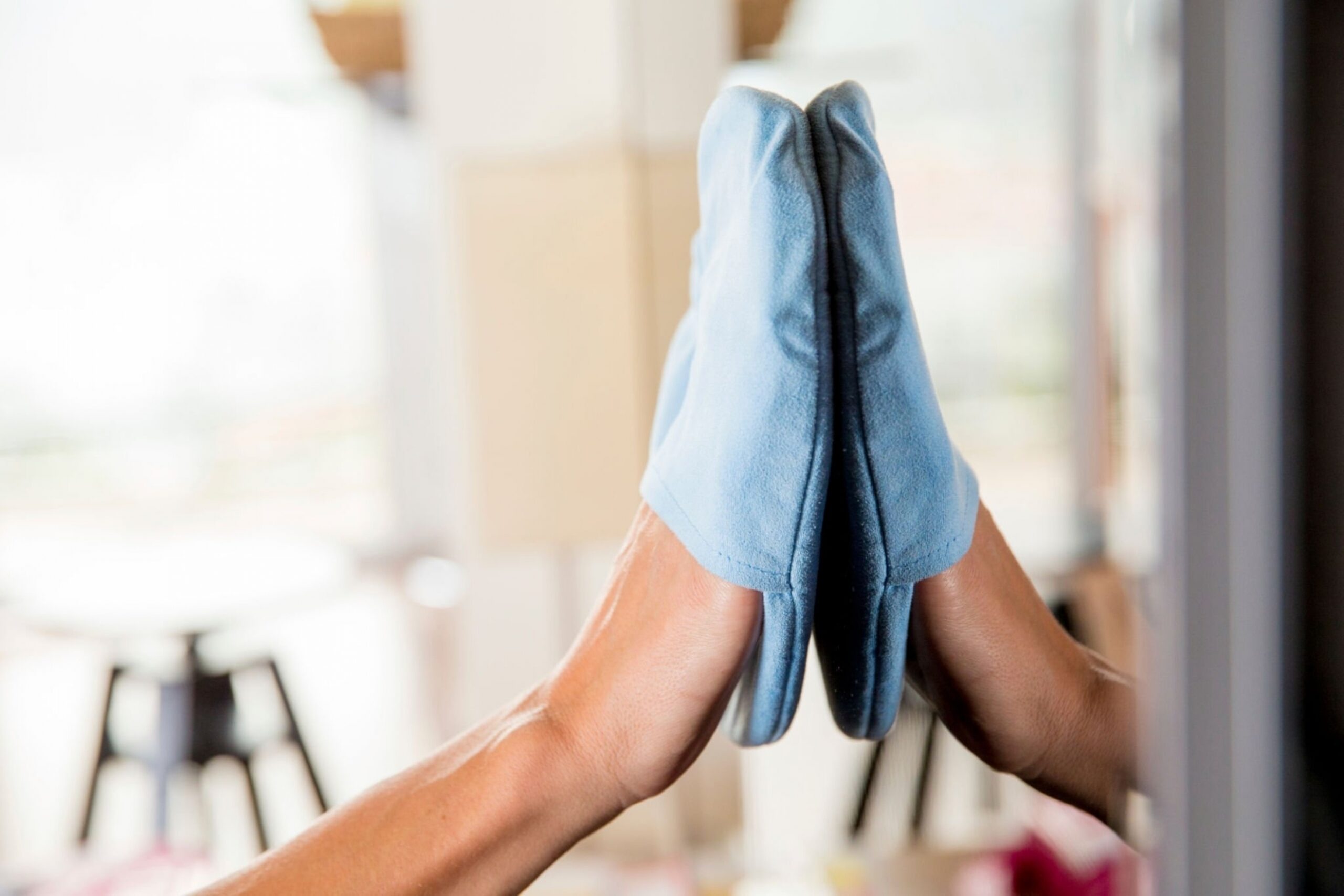
With regular care and cleaning, your TV screens should be looking their very best. If you’re looking to make sure your TVs, remotes, and a speakers look and operate at their best, here are a few extra tips and tricks to incorporate into your regular cleaning routine:
- You should clean your TV screen about once a week to regularly remove fingerprints, streaks, smudges, and other mysterious stains that may appear.
- Use your vacuum hose to suck up the dust and debris from any wires and ports behind the TV itself when you clean it to ensure that everything stays in good working condition.
- Avoid cleaning your TV screens with harsh chemical cleaners and products. Substances you should never use to clean your modern TV screens include:
- Ammonia
- Acetone
- Rubbing alcohol
- Never spray cleaning solutions directly onto the screen itself, no matter if the TV is a newer model or an older one. Remember to spray the solution onto a cloth and wipe the cloth on the screen to clean it.
- Remember to dust the TV screen before cleaning it, and also remember to not use too much pressure when wiping away stubborn fingerprints or stains from the screen.
FAQs
What household product can I use to clean my TV screen?
You can use an equal mixture of white vinegar and water, distilled if possible, to clean your TV screen. Make sure that you apply the solution to a microfiber cloth and not directly to the screen itself so as to not damage the device.
What can I spray on my flat screen TV screen to clean it?
You should never spray any cleaning solution directly onto your TV screen. The safest cleaning solutions to use are screen or glasses cleaner, or a mixture of vinegar and distilled water, both of which should be applied to a microfiber cloth in order to clean the TV screen.
Can you use alcohol wipes on TV screens?
Premoistened alcohol wipes that utilize no higher than 70% isopropyl alcohol can be used to clean many TV screens, but better methods are recommended. Most professionals advise against using alcohol based products to clean modern TV screens, some make sure to check your TV’s user manual for cleaning and upkeep information.
Can I use glasses cleaner on my TV screen?
Glasses cleaner is safe and can be used on most TV screens when used with a soft microfiber cloth. Be sure to not spray the cleaner directly onto the screen when cleaning.
What can ruin a TV screen?
Heavy finger pressure, spraying liquid cleaning products directly onto the screen, moving the screen panel, and use of any heat can very easily ruin and warp your TV screen. When you are looking to clean your TV screen, always consult the owner’s manual and professional cleaning guides before any cleaning is done on or around the screen.

With regular cleaning and dusting, your TV screen will be looking clear and free of stray smudges just in time for your next binge-watch or movie night. What kind of screen cleaning tips do you use for your TV screens? Have you made any cleaning mistakes and want to share some advice? Leave a comment below, we’d love to hear from you!
If you’re looking for some extra help around your home, we’re here to help. You can check out our website to read our blog posts or see what kind of services we can offer you. If you’re in need of some high quality cleaning around your office space or business, please check out our commercial cleaning services Denver and book your cleaning services today!
The post Grubby TV Screen? Here’s How to Fix It! appeared first on Cleanzen.
from Cleanzen https://cleanzen.com/blog/how-to-clean-tv-screen/
via IFTTTfrom Cleanzen Cleaning Services https://cleanzencleaningservices0.blogspot.com/2023/03/grubby-tv-screen-heres-how-to-fix-it.html
via IFTTTfrom
https://cleanzencleaningservices0.wordpress.com/2023/03/01/grubby-tv-screen-heres-how-to-fix-it/from Gabriela Bragg https://gabrielabragg.blogspot.com/2023/03/grubby-tv-screen-heres-how-to-fix-it.html
via IFTTT -
10 Genius Tips for Packing for Your Move
Moving is a huge task for everyone, especially if you’re going through the whole process on your own. There always seems to be too many items to pack away and too little space in the boxes, not to mention the random items that tend to appear as soon as the boxes are sealed.
While there is no universally correct way to pack for a move, there are some ways you can make the whole process more efficient and less stressful. Here are a few of our best-recommended tips and tricks for packing for your upcoming move.
1. Have a Plan
Before you start throwing things into boxes just to get them out of the way, take a moment to organize and plan the process. First and foremost, you’ll need to make sure you have everything you’re going to need for the packing process before you actually start packing. Here is a small list of packing essentials:
- Sturdy multi-sized boxes
- Durable packing tape
- Bubble wrap or paper cushioning
- Label stickers
- Permanent markers
- Moving blankets
- Color coding materials
- Notepad or binder
Once you have all your materials on hand and ready to go, you should make a plan for how you’re going to be packing each room as well as how you’ll be sorting each item. Placing things into boxes simply however they fit isn’t particularly safe or efficient, it is best to be mindful of how you pack up the rooms of your home. Plan for the boxes you’ll need for each room as well as how to make sure any delicate or sentimental items are safe when moving.
2. Purge While You Pack
Moving is the best time to get rid of non-essential clothing and home goods from around the home. Throwing out, donating, or selling items you don’t want to bring with you to your new space or won’t have room for is the best way to minimize the hassle of packing and unpacking. Set aside some space to organize things you plan on getting rid of or are on the fence about bringing, and until you make a decision or are ready to say goodbye, it’ll all be out of the way of the rest of your packing.
You should start the purging process as soon as possible, too. In fact, the best time to start is a few months ahead of your big move so that you won’t be in a rush while making choices and risking any mistakes along the way. Be thorough and motivated when decluttering so that you’ll only be bringing the good stuff that makes you and your family happy into your new home.
3. Make a List

You made your plan for packing up each room already, but how do you know what to pack in each room and in what order? Now is the time to sit down and organize a list of the items that will be packed up in each room, as well as items that you’ll be saving for the final moving day. This way you’ll be able to cross things off and make a note of what still needs to be done so you won’t be running around trying to figure out why certain things haven’t been packed yet.
The more organized and thoughtful you are about the packing process, the less stressful and chaotic the unpacking process will be. Remember that you are basically saving your future self a huge amount of time and headaches when you make notes and lists. Be meticulous and over-prepared now so that you’ll be ready for everything later.
4. Round Up Cables
Electronics and their respective wires and chargers can easily take up tons of space when packing up the house. Plus if you’re anything of a pack-rat, you might have a pile of cables and cords that you haven’t figured out how to use around the house in some time. To make packing these lengthy and mismatched wires a simple task, try these tips:
- Sort them out by capability
- Keep current spare phone chargers in an accessible location
- Make sure wires are untangled before wrapping or rolling them up
- Use a twist or zip tie to secure cords
- Place cords in labeled bags to save space
- Keep bags of cords with corresponding electronics
5. No “Almost Empties”
We mentioned decluttering earlier, but here’s something to keep in mind when it comes to the bathroom and kitchen in particular. If you have any items that have been so close to empty or sat broken in a drawer for far too long, it’s time to toss them out. These little “almost empties” and broken or worn-out items don’t need to take up any space in a box or bag that is already near capacity. Here is a little example of the items that don’t need priority space in your moving boxes:
- Mealtime leftovers
- Close to empty condiments
- Cleaning supplies on their last use
- Worn out and stained towels
- Large bottles with little product
- Thoroughly squeezed tubes of toothpaste
- Broken tools or electronics
6. Label EVERYTHING

This little tip should basically be a no-brainer: put labels on every box and bag you fill. Future you should have no questions as to where something is or what’s in a particular box. Label the top and sides of each box so that everything can be sorted and organized properly at any stage of the process. Make a system for packing up each room and make sure everything is labeled accurately. You should also make sure that boxes containing glass and other fragile items are clearly and obviously labeled so that there is no risk of anything breaking.
You can also simplify things by creating a color-coding or numbering system for rooms or zones within your current and new homes. Grab a set of colored stickers or markers and map out how everything can be organized and unpacked when it comes time for that. We’ll say it again: remember to save your future self a headache!
7. Know the Contents
When you’re packing your moving boxes in each room, make a note of what you’re placing in each one. We suggest having a physical list of the contents of each box so that you know exactly where everything is. You can keep track of everything best when you have a color coding system or number assigned to each box, that way you can make sure every box goes to the right room when you’re starting to unpack.
Another great reason to have a list of each box’s contents is so that if you hire a moving company, the movers know to be careful when moving your items into and out of their truck. You’ll also be able to tell if any items or whole boxes are missing after you’ve moved and be able to let the company know what you’re looking for. It is best to be prepared for anything, especially when moving.
8. Save the Essentials for Last
As you get closer and closer to moving day, you’ll probably start to notice how empty your home feels when everything is being packed away. However, not everything in the home should be tucked neatly away. Your toiletries, frozen and refrigerated food, in-season clothing, medications, and kid/pet supplies should remain unpacked until the day of the move. What would be the use of packing all your clothes away if you’re still going to need to wear them?
No one likes living out of boxes, so remember to set your daily essential items aside while you pack up everything else. We suggest having a designated space or room in which everyone can set aside some clothes, electronics, supplies, and toiletries so that everything you don’t need to pack yet is out of the way.
9. Keep Cleaning Supplies Handy
When you clear a room of everything that can be packed up and removed, you’ll likely notice how much dust and debris has accumulated. Ideally, you’ll also notice that you now have access to areas of the room that haven’t received TLC in years. Our tip is to keep your cleaning supplies and equipment unpacked and at the ready so that you’ll be able to give each room a deep clean once it’s been completely packed up.
Here are some cleaning essentials to have on hand before moving day:
- Multi-surface cleaner
- Glass cleaner
- Shower/ tub cleaner
- Cleaning rags or paper towels
- Disinfectant spray/ wipes
- Rubber gloves
- Vacuum
- Broom/ sweeper mop
- Carpet cleaner
- Mop
10. Make an Unpacking Plan
One of the best ways to simplify the unpacking process once you’ve transferred all of your belongings to your new space, is by having a plan. If you’re lucky enough to have access to your new home before you officially move out of your old one, you can start the unpacking process anytime you want!
Try setting goals or having an organizational motivation when you unpack, you’ll get the job done in no time. Better yet, before you unpack, make sure you have bins, shelves, and other organizational tools for around the house to keep everything looking as tidy as possible. Welcome to your new home!
Benefits

If you’re wondering why you should even bother putting in extra time and effort when packing for a move, allow us to resolve that. We know packing can be a pain and can often become chaotic and overwhelming, but imagine if there was no rhyme or reason for the way you packed your moving boxes. Unpacking would be just as hectic, fragile items could break during the move, sentimental family belongings could be lost, and your new home could become even more of a mess than your old one.
When you create and utilize a system for packing each room and item within your old home, you are more mindful and careful with the things you love. Moving is an opportunity to get organized and declutter down to the essentials so that you can come into your new space with a clear mind and tidy atmosphere. Take some time to throw out the old so that you can truly start fresh with the new!
FAQ
Where do I start decluttering for a move?
When you are starting to declutter your home before a move, you should always start in the room you and your family use the least so that you have a space to set aside your essential items for later. Once your essentials are out of the way, decluttering and packing each room will be easier.
What do movers move first?
Professional movers will almost always move the largest and heaviest items in the home, like furniture and appliances, first. This is to ensure that there will be space on their truck for other pieces of furniture and moving boxes.
How do I start a moving plan?
When creating a plan for moving, always start by creating a room-by-room packing checklist and set aside a budget for a moving company and packing supplies. You’ll also want to start decluttering every room of your home as early as possible so that you’ll only be packing necessities.
What order should you move stuff in?
When moving, you should move your larger furniture and appliances first, followed by smaller and non-essential items. If you aren’t bringing appliances, you should still ensure that your larger furniture is loaded onto the moving truck first so that there is room for smaller furniture and boxes later on.
What should you not do when moving?
The most important things you should never do is not allow yourself enough time to pack properly and not packing with care or purpose. Packing moving boxes is a very important part of the moving process and can even make or break the whole moving experience.

Are you planning and packing for a big move soon? What kind of packing and planning tips have you come across and would like to share? Tell us about your tips and tricks in the comments below, we love hearing from our readers and clients!
If you’re looking for more helpful guides for around the house, or if you’re in the market for a move-out or move-in cleaning for your home, new or old, we’ve got you covered! Check out www.cleanzen.com/chicago to read more from our cleaning and lifestyle blog or to browse our selection of cleaning services. Contact us today to see how we can help you out around the house!
The post 10 Genius Tips for Packing for Your Move appeared first on Cleanzen.
from Cleanzen https://cleanzen.com/blog/how-to-organize-your-move/
via IFTTTfrom Cleanzen Cleaning Services https://cleanzencleaningservices0.blogspot.com/2023/02/10-genius-tips-for-packing-for-your-move.html
via IFTTTfrom
https://cleanzencleaningservices0.wordpress.com/2023/02/22/10-genius-tips-for-packing-for-your-move/from Gabriela Bragg https://gabrielabragg.blogspot.com/2023/02/10-genius-tips-for-packing-for-your-move.html
via IFTTT -
Speed Clean your Home in 20 Minutes (Daily Cleaning Guide)
Cleaning up around the house can be time consuming and tedious, especially when you do it all in one day. What if we told you that there was a better way to tidy? All you have to do is break down your usual checklist into different days and you’ll be able to get more done in less time each day. We’ve put together a handy cleaning guide to help you figure out how to break up your cleaning tasks for the week, all you have to do is tailor it to fit your home and your schedule.
Every Day
While breaking most of your to-do list into smaller lists for different days is the best way to make cleaning more manageable, there are still things you’ll want to take care of every day. These are the tasks around the house that you’ll want to make sure you tackle every day:
- Wipe down countertops and high-touch surfaces
- Do the dishes after each meal
- Sweep or vacuum around the kitchen and high-traffic areas
- Make the beds in every bedroom
- Put everything where it belongs
- Clean the kitchen table after each meal
- Use a squeegee or cloth to remove water after a shower or bath
- Clean spills and sticky spots
For the remaining tasks on your regular checklist, we can break them down and assign a set of tasks to each day of the week. You’ll want to try and keep your daily cleaning tasks simple and manageable each day so that you aren’t taking up too much of your time each day. You can follow our basic guide below, and use it to help you create your own daily checklist for the week.
Monday

On Mondays, you can keep things simple and make sure your home is tidy and ready for the week ahead. Try sticking to these tasks:
- Dust around the living room, from ceilings to baseboards
- Clean glass surfaces and mirrors
- Load and run the dishwasher
- Pick up clothing and do laundry for the week.
Tuesday
On Tuesdays, you can tackle some of the crud and clutter from around the house.
- Declutter and throw away expired food
- Empty trashcans around the house
- Clean the sinks and toilets
- Mop or vacuum all the floors and carpets
Wednesday
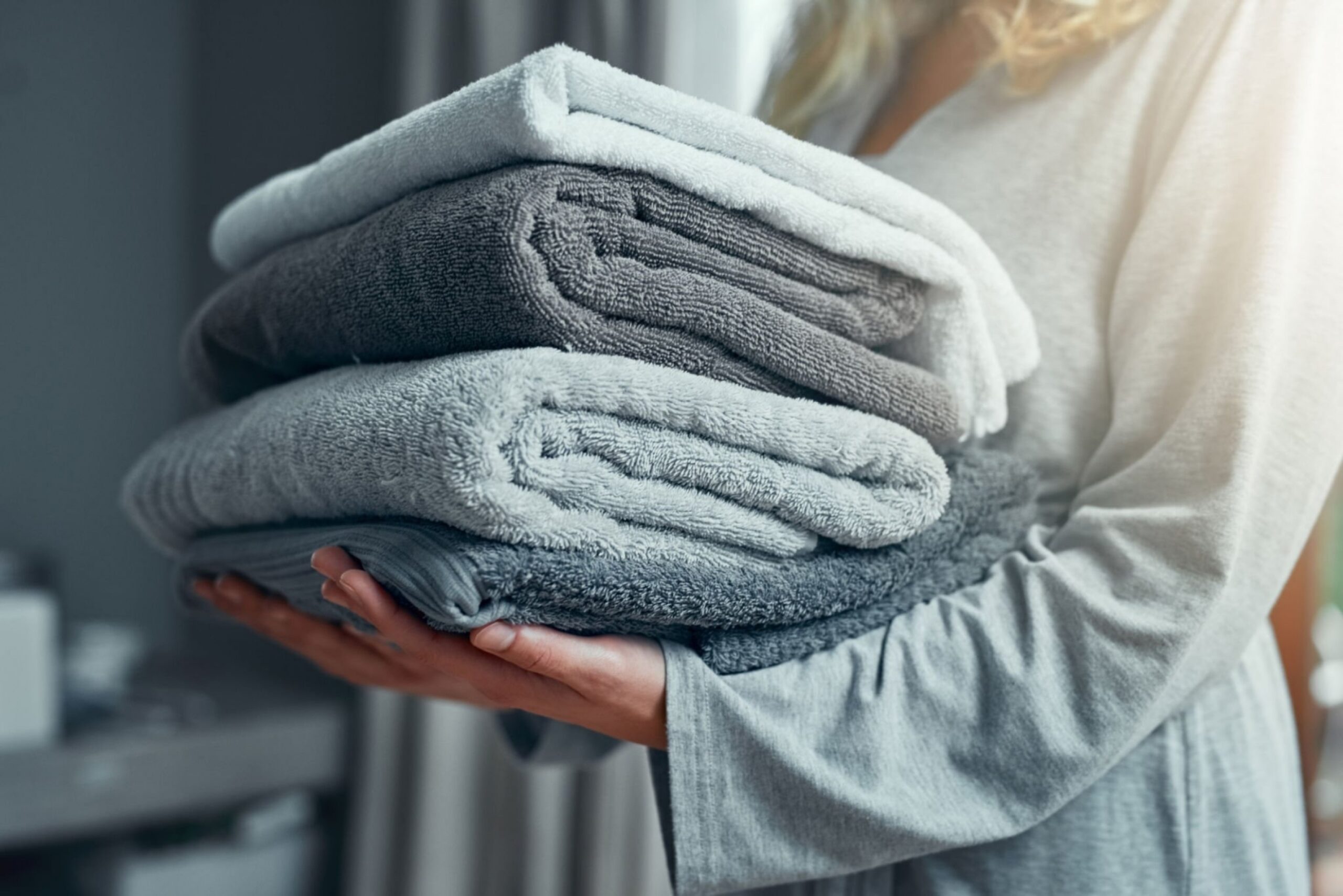
Wednesdays are great for mid-week tidying and making sure everyone in the home knows to keep it clean.
- Dust and wipe down cabinets
- Organize the paper clutter around the house (bills, mail, cards, etc.)
- Wash and fold/ rehang towels
- Pick up kids’/pets’ toys from around the house and put them away
Thursday
On Thursdays you can make sure both the inside and outside of the home look their best and get some attention.
- Clean in and around the microwave
- Fold up and put away/reset throw blankets and pillows in the living room
- Clean the shower or tub
- Tidy up around the garage and front porch
Friday
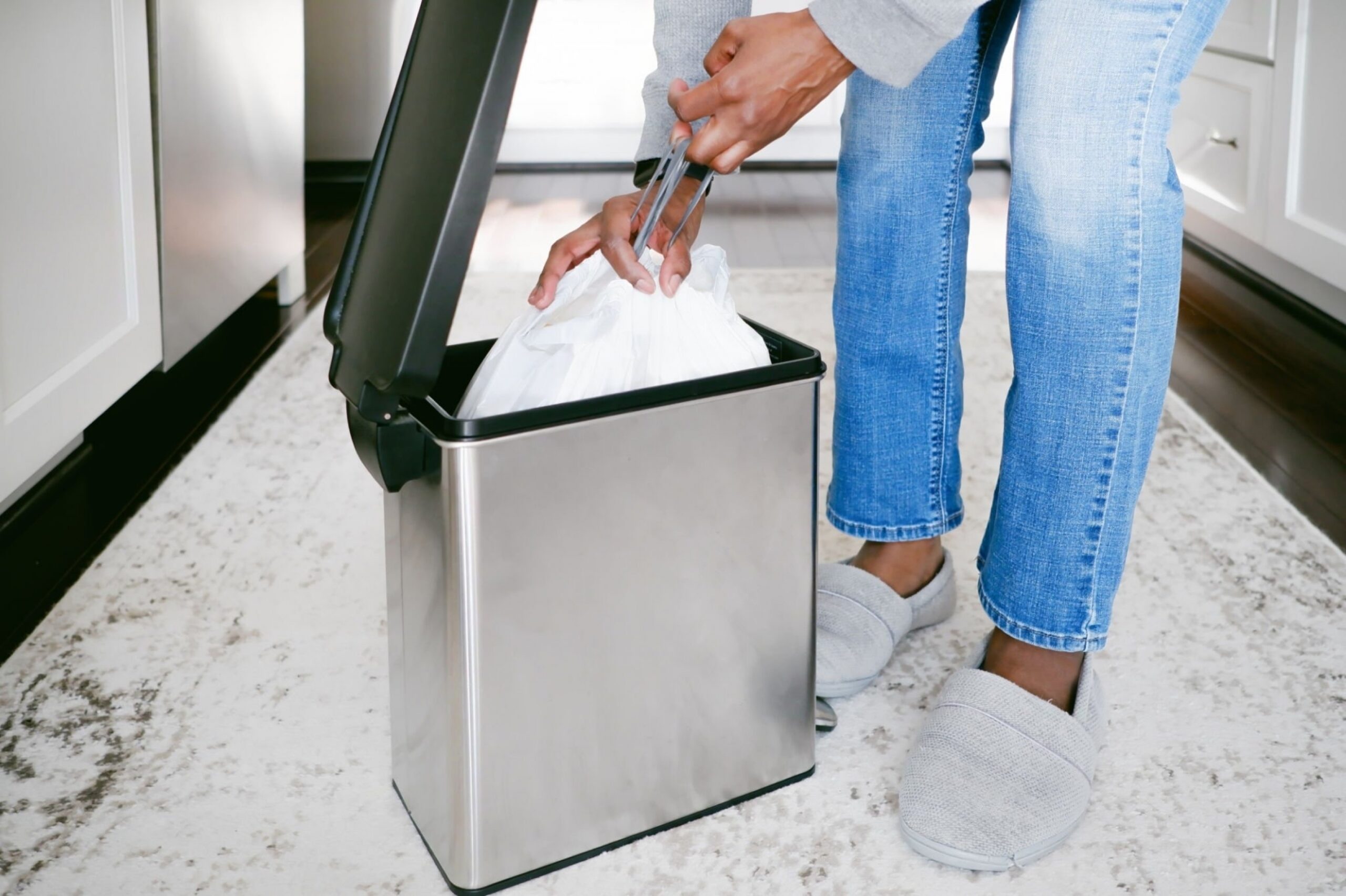
Finally, Fridays are perfect for making sure the house is ready for the weekend and for potential guests or just resetting for the next week ahead.
- Organize the fridge and pantry
- Take out the trash from around the house for the week
- Wash and refresh bathmats and curtains
- Sanitize and disinfect high-touch items (phones, remote lights, etc.)
Don’t Forget Deep Cleans
When you need to give your home a little extra care and attention throughout the week, that’s okay. Every home is different and some may require more upkeep and care than others. Here are a few more in-depth cleaning tasks you can add to your daily routine when you need a deeper clean:
- Get rid of musty smells in the dishwasher and washing machine by cleaning them
- Empty out the fridge and freezer and clean the shelves and drawers
- Move and clean under large furniture
- Clean and degrease the inside of the oven and your range hood
- Clean and descale hot water kettles and coffee makers
- Wash your bedding and deodorize the mattress
- Check and clear the house’s gutters
- Wash and clean the windows
- Clean outdoor furniture and cooking surfaces
Quick Tips and Tricks
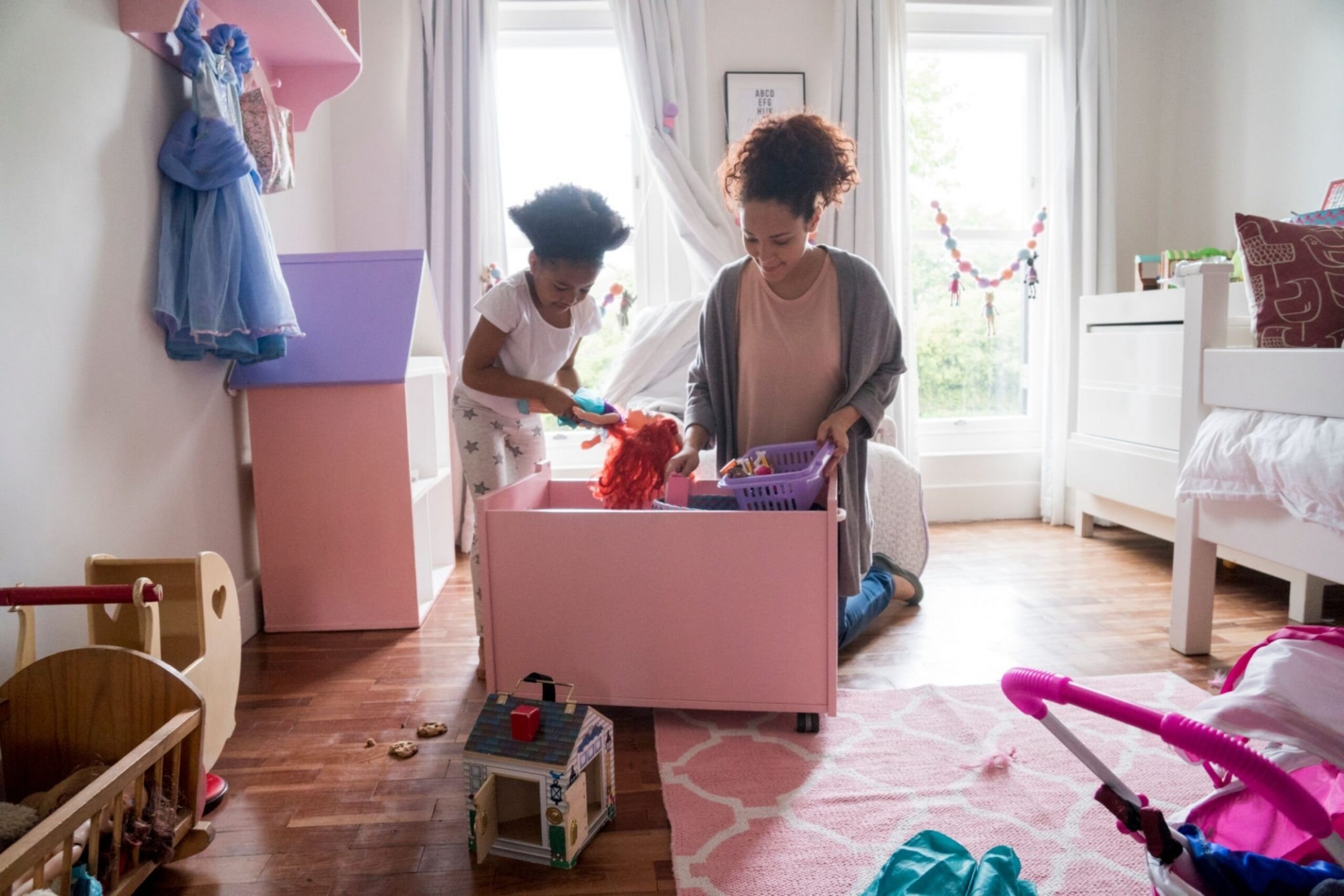
Now that you have a general idea of how you can create your daily cleaning checklist for you home, you’re well on your way to living clean. But how can you further simplify the cleaning process around the house? Allow us to offer some of our favorite tips and tricks for keeping cleaning easy each week:
- Keep cleaning supplies in the bathrooms for easier access
- Clean up as you cook
- Have laundry baskets handy in bathrooms and or bedrooms
- Stick to a no-shoes policy to minimize dirt and mud around the house
- Keep clutter off kitchen counters
- Take the extra minute to put things away when you’re finished with them
- Put away and hang clothes as soon as they’re clean
- Multitask as much as possible when cleaning
- Teach kids to put their toys away when they’re done playing
- Consider investing in tools like a robot vacuum or self-cleaning litter box
- Have shower cleaner at the ready when you’re done bathing
FAQ
What is a house cleaning checklist?
A house cleaning checklist is a wonderful and effective way to keep tasks organized and clear when cleaning up around the house. It is also a great way to get everyone involved by dividing tasks by room or by difficulty so that even kids can help out.
How do I make a daily cleaning checklist?
You can create your own daily cleaning checklist by looking around each room to see what needs to be done, writing them down in a list, and then dividing tasks by frequency, how long they’ll take to finish, or by family member.
What is the 20-10 method of cleaning?
You can follow the 20-10 method, created by Rachel Hoffman, by working on your cleaning tasks for 20 minutes and then taking a 10 minute break before starting your next set of tasks. This is a great way to stay motivated and focused on cleaning when you have a lot to tackle.
How can I clean my room in 15 minutes?
The best way to clean up any room in 15 minutes is by picking up clothes, putting items back where they belong, gathering bits of trash, resetting pillows and blankets or making the bed, wiping down surfaces, and sweeping or vacuuming. A quick 15 minute tidy is a good way to make sure your home looks more presentable and ready for potential guests.
What are the 8 steps in cleaning?
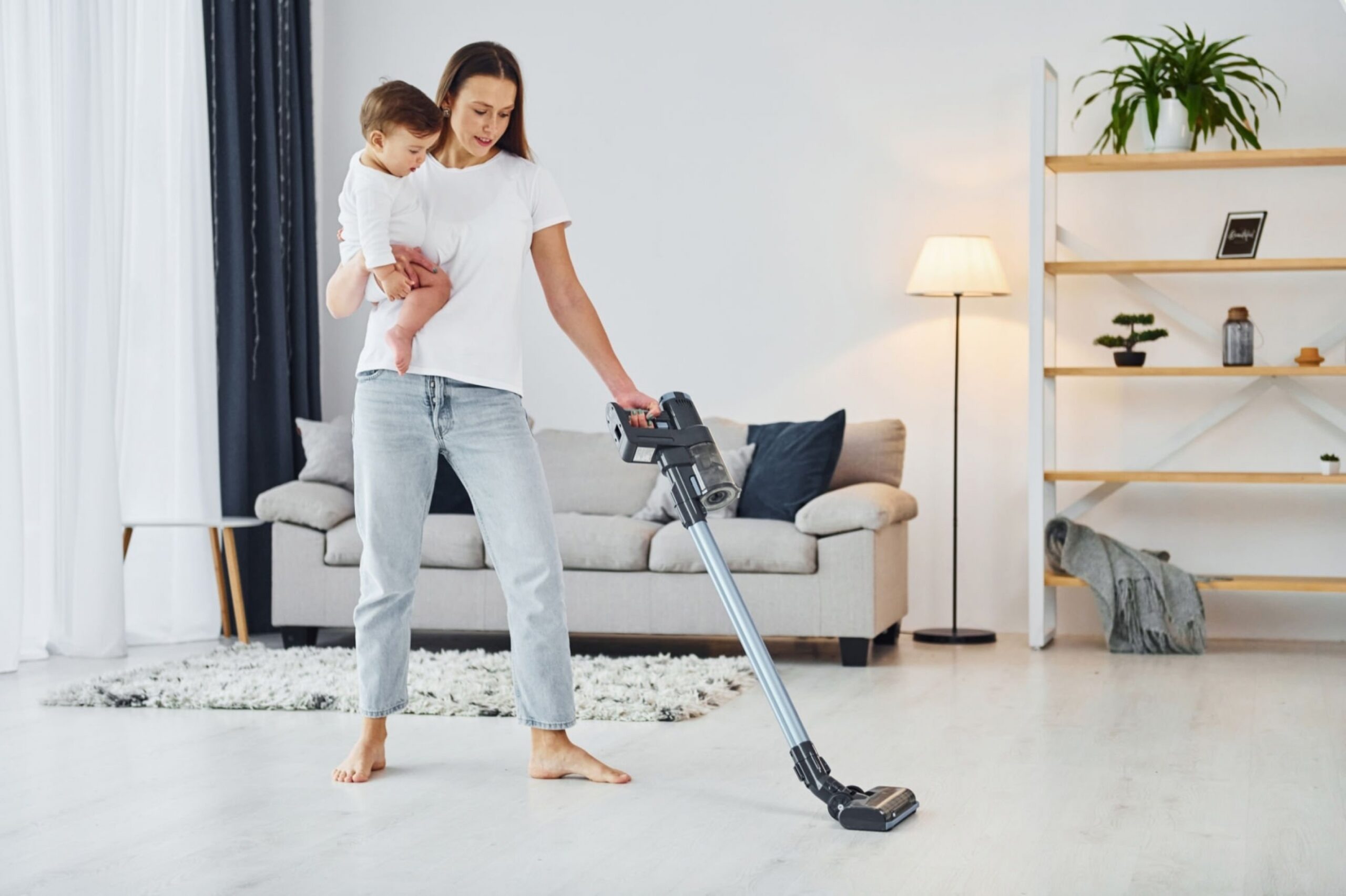
The 8 steps you can follow for cleaning any room are:
- Have all your tools and supplies ready
- Tackle the clutter
- Dust and vacuum from top to bottom
- Wipe down surfaces and clean glass an mirrors
- Disinfect high-touch surfaces and items
- Scrub toilets, sinks, and tubs
- Sweep and mop in that order
- Make sure everything is in its proper place
How do I clean my whole house?
To clean your whole house, work efficiently by starting with bathrooms, then the kitchen, hallways and entries, the living room, and finally bedrooms. You’ll also want to make sure to clean the home and each room from top to bottom to ensure that there is no residual dust and debris after you’ve finished.
How can I clean my house in 10 minutes?
If you’re in a hurry and need to clean your whole home in 10 minutes, here is what you should prioritize:
- Clear and wipe kitchen and bathroom counters
- Dust lights, shelves, baseboards and other clear surfaces
- Spray or apply cleaner to showers/tubs and toilets and allow it to soak while you clean the sinks and mirrors.
- If you have time, do a sweep or vacuum around the entryways and carpets.
We hope this little guide helps you keep your home looking and feeling tidier throughout the week. Remember that you can change and organize your list however you need to so that it fits your home and schedule. How does your checklist look? What kinds of cleaning tasks do you include in your daily cleaning routine? Share your routine and even your best tips and tricks with us in the comments below, we love to see how you stay tidy!
For more cleaning tips and to find out how we can help you around the house, check out our homepage. You’ll be able to find out what services we offer, schedule an appointment or book our cleaning services, and even read through our blog to see how you can keep your home looking and feeling amazing on your own. Contact us today to find out how we can help!
The post Speed Clean your Home in 20 Minutes (Daily Cleaning Guide) appeared first on Cleanzen.
from Cleanzen https://cleanzen.com/blog/daily-cleaning-checklist/
via IFTTTfrom Cleanzen Cleaning Services https://cleanzencleaningservices0.blogspot.com/2023/02/speed-clean-your-home-in-20-minutes.html
via IFTTTfrom Gabriela Bragg https://gabrielabragg.blogspot.com/2023/02/speed-clean-your-home-in-20-minutes.html
via IFTTT -
The Ultimate Guide to Cleaning Your Windows
Cleaning windows can be a struggle, especially when it’s time to finally clean the outside. We know window cleaning is almost nobody’s favorite chore, but there’s no reason it should be more complicated than it is. To help keep window cleaning simple, here is our guide to cleaning your home’s windows, inside and out, like a professional.
Get the Windows Ready for Cleaning
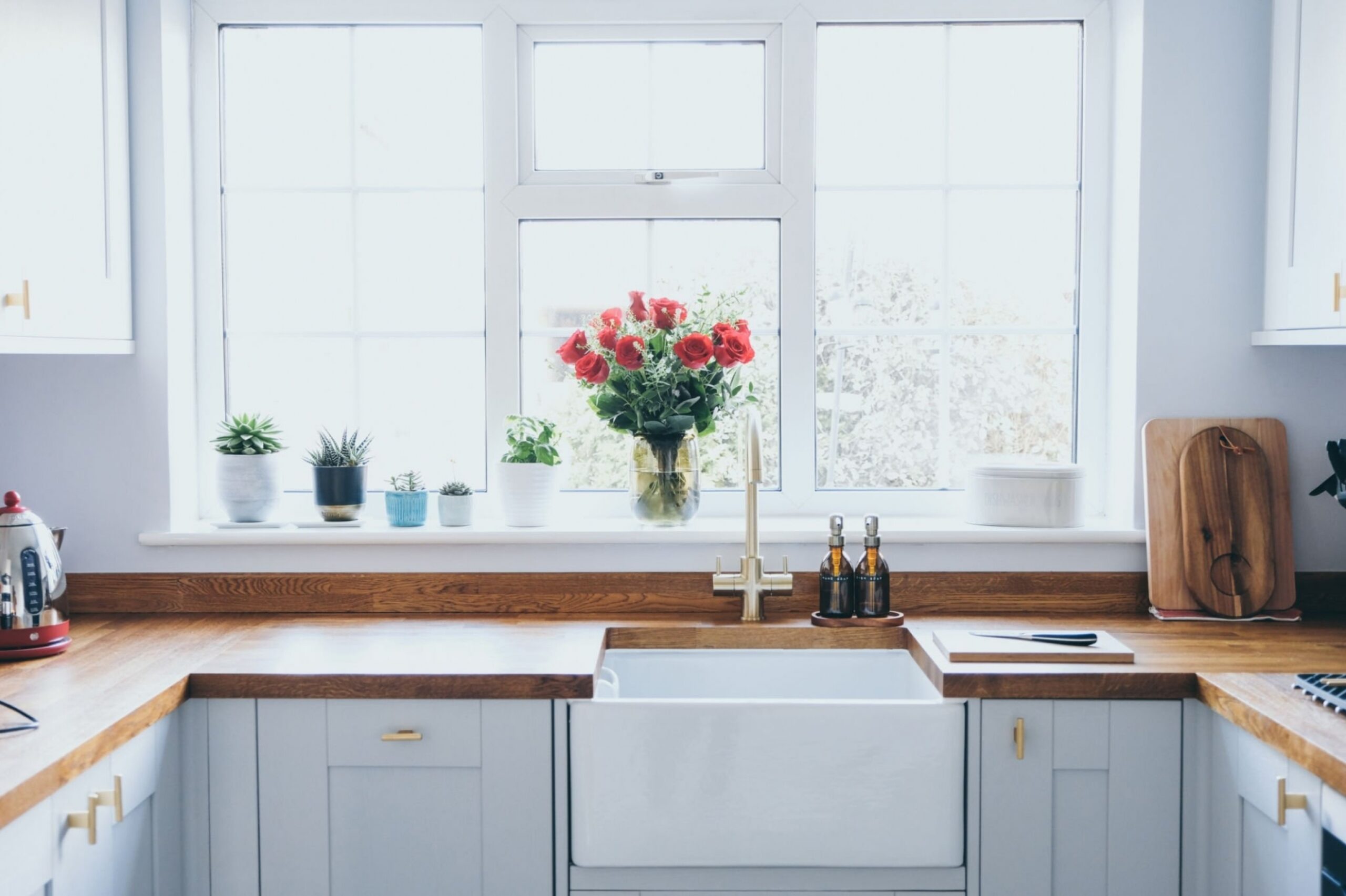
Before you start, you should ensure you and your home are prepped and ready for cleaning. Since you’ll be using cleaning products and water, you’ll need to protect the areas around your windows. Here are a few things to keep in mind when prepping:
- Lay a towel down under the window you’ll be focusing on, and make sure you have a few extras on hand just in case.
- Remove any dust and loose debris from around the windows with a vacuum or by wiping down the area with a damp cloth.
- Pull up any blinds on the windows and give those a good dusting to keep them from redistributing debris on the newly cleaned windows later.
- Move any curtains out of the way. Shake them out outside and maybe toss them in the wash or a quick tumble in the dryer if they are fabric.
- If your windows have removable screens, you’ll want to get those out of the way. Make sure to label them so that you can put them back correctly. It could also be a good idea to rinse the
- screens with a hose and allow them to dry in the open air before replacing them.
- Have all your cleaning supplies ready. You’ll need: Microfiber cloths (Note: We don’t recommend paper towels or newspapers as these are more likely to leave streaks, haze, and lint on the glass.), a squeegee, a spray bottle, glass cleaner or cleaning solution of choice and water.
DIY Window Cleaner
If you’ve tried just about every glass cleaning product available and haven’t found one that works, you most likely have the solution at your fingertips. Here are some of our favorite DIY window and glass cleaning solutions:
1. Vinegar
This method is our best recommendation, and it’s super simple! All you’ll need is white distilled vinegar and some water, plus your spray bottle. In the spray bottle, combine 1 part vinegar with 2 parts water and then shake it gently to mix it together. The acidity of the vinegar is what makes this so effective as a glass cleaner, plus it can kill bacteria and cut through tough grime. We told you this method was easy!
2. Lemon Juice

If you don’t like using (or smelling) vinegar around the house, that’s okay. We know vinegar can be pretty strong and harsh on the nose, so here’s your solution. All you have to do for this DIY method is replace vinegar from the previous recipe with lemon juice. The acidity of the lemon juice is a bit stronger than vinegar, but it is just as effective and definitely smells better. Who doesn’t appreciate their home smelling lemony-fresh after cleaning?
3. Dish Soap
There are a few ways you can incorporate dish soap into DIY cleaning solutions. You can easily use it on its own by adding a few drops to some clean water, giving you an effective window cleaner. Another effective way to use dish soap is by adding a drop or two to either of the previous recipes for a pretty powerful cleaning boost.
4. Tea Tree Essential Oil
Another way to combat the scent of chemicals or vinegar is by adding essential oils to your DIY recipes. Our favorite essential oil to use is tea tree because not only does it smell amazing, but it also fights against bacteria and helps prevent mold growth. You only need to add a few drops to your DIY cleaner to see the difference, so we suggest using essential oil with our favorite vinegar method for the ultimate cleaning solution.
Cleaning Inside
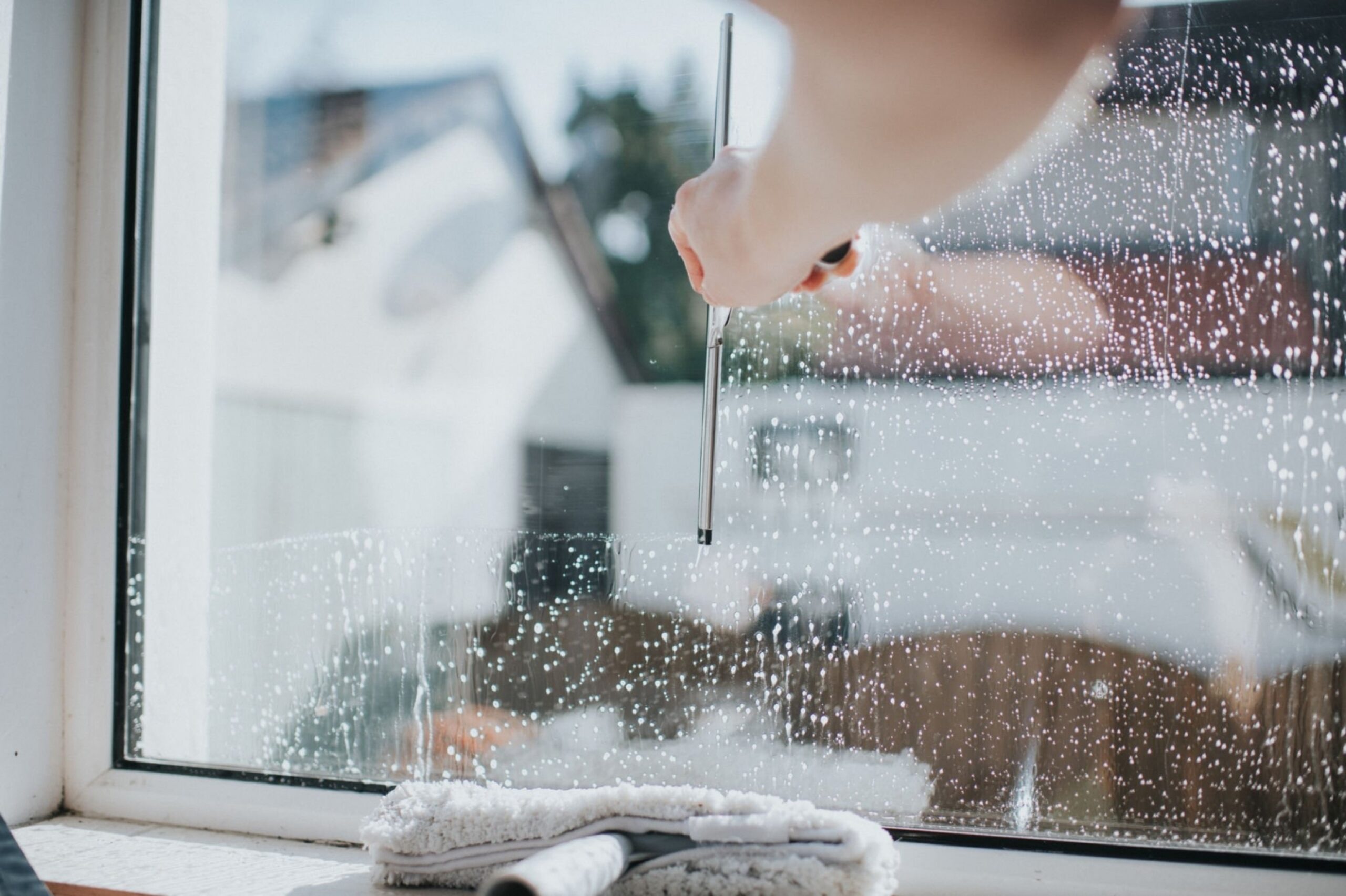
Now that you have the area around your windows protected and your supplies at the ready, you can get started with the cleaning process from inside. Here is our quick guide to cleaning the interior of your windows like a pro:
- Make sure you have wiped down the windows and window panes with a wet cloth to remove any loose dust and debris from the surface.
- Using your chosen cleaning product or DIY solution, spray a small amount starting from the top of the window glass and moving down. (Note: Do your best to keep the cleaner away from surfaces that aren’t glass.)
- Wipe the cleaner all around the glass with a dry microfiber cloth to clean the window using an S-motion to avoid the cleaner drying on the glass while you clean it.
- Spray a small amount of cleaner on any stubborn areas of grease or grime around the window. Only use the cleaner in small amounts and do your best to not allow the cleaner to pool at the base of the window.
- Using a fresh microfiber cloth or a squeegee, wipe away the remaining cleaner once the glass has been cleaned completely. If you are using a squeegee, make sure you keep the blade in contact with the glass to avoid leaving streaks and drips.
- Check the glass for any streaks or stray marks. You can use a fresh microfiber towel to buff these from the surface of the glass for a shiny and streak-free finish.
Cleaning Outside
Once all of your windows are now shiny and clean on the inside, make sure they’re all closed because it’s time to shift your focus to the outside. For the best results when cleaning your windows from the outside, here is our go-to method:
- Ensure that all windows are securely closed and surrounding areas inside are protected from potential leaks.
- Use your garden hose to spray away the surface layers of dirt and grime that have accumulated.
- To scrub and remove stubborn grime, we recommend using an extendable pole that you can attach microfiber cleaning cloths to. Climbing up and down a ladder to clean your windows is time-consuming and even dangerous especially if you are cleaning them on your own.
- Apply your cleaning solution to the cloth on the extendable pole to clean high-up and hard-to-reach windows. (Note: There are some hose-attachable window cleaners available to purchase, so you can look into one of those to shave off some time when cleaning.)
- Rinse the cleaner away thoroughly with your hose.
- Use a fresh microfiber cloth or extendable squeegee to dry the windows.
How Often to Clean Windows
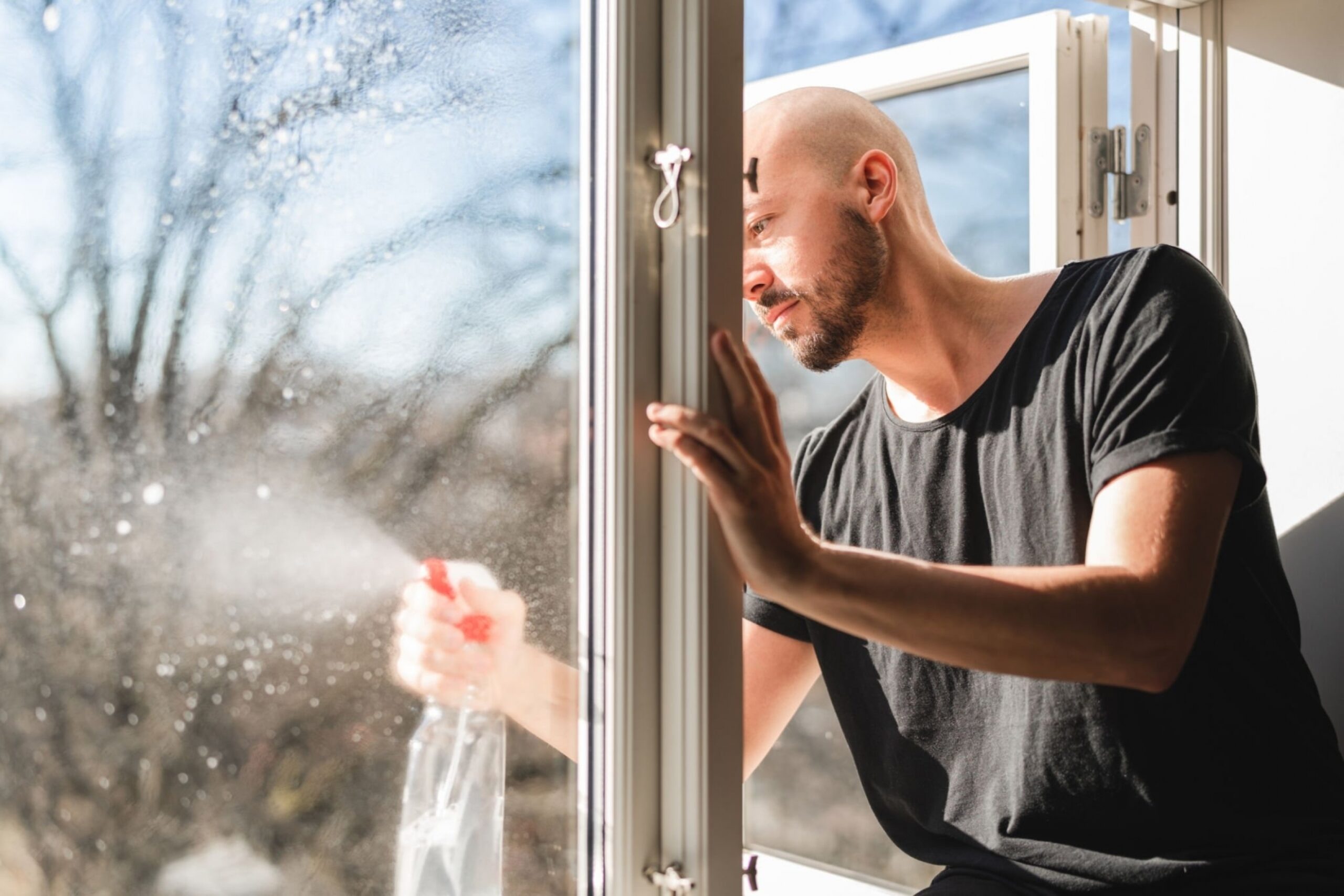
We know cleaning your windows can be a time-consuming chore to take on, especially when you’re cleaning both inside and out. Thankfully, you should only have to clean both sides of your windows about 2 or 3 times a year, depending on the environment where you live. Pollen levels, rainy weather, tree sap, and even birds can add to the debris that collects on and around your windows. Make sure to regularly check the state of your windows from the outside in order to stay on top of their cleanliness.
FAQ
What should you not do to clean windows?
When cleaning your windows, you should not use an ammonia-based cleaner and avoid cleaning them in direct sunlight as both of these can create excessive streaking and haze. You should also aim to use a squeegee when drying them and removing excess cleaner and water.
What causes windows to get dirty inside?
Windows can get dirty inside because of dust, grease, and other particulates that accumulate and stick to the glass. Windows in the kitchen are especially susceptible to grease build-up and can be particularly difficult and stubborn to clean.
Can vinegar damage glass windows?
Vinegar won’t damage and is completely safe to use on glass windows and mirrors. In fact, we encourage it! Just remember not to use vinegar to clean anything like electronics or stone such as granite and marble.
What do professional window cleaners use in their water?
Many professional window cleaners use purified and treated water, but they can also use simple cleaning agents like a few drops of dish soap in water. This solution is super simple but highly effective when cleaning windows, which is why we suggest trying it out for yourself.
What is the best time of day to clean windows?

The best time of day to clean your windows is early in the morning before the sun is fully up so that it doesn’t hit your windows directly. You can also save window cleaning for an overcast day without rain, as long as there is no direct sunlight on your windows. This is because the sunlight can cause your cleaning solution and water to evaporate more quickly and leave water stains and streaks on the window while you clean.
Why do my windows look worse after cleaning?
Your windows can look worse than when you started often because of the amount of sunlight hitting them or even if you leave the solution for too long and it dries on the glass. Your home’s water can also be a contributing factor to streaks and haze as hard water leaves cloudy mineral deposits on most surfaces.
How do your windows look after cleaning then? What kind of cleaning tips and tricks do you use when cleaning your windows? Share your thoughts in the comments below, we love hearing from you! If your windows have become too much of a struggle to keep clean and shiny on a regular basis, don’t worry. You can check out cleanzen.com/philadelphia to find out what kind of services we offer that can help you keep your home looking its best.
The post The Ultimate Guide to Cleaning Your Windows appeared first on Cleanzen.
from Cleanzen https://cleanzen.com/blog/how-to-clean-windows/
via IFTTTfrom Cleanzen Cleaning Services https://cleanzencleaningservices0.blogspot.com/2023/02/the-ultimate-guide-to-cleaning-your.html
via IFTTTfrom Gabriela Bragg https://gabrielabragg.blogspot.com/2023/02/the-ultimate-guide-to-cleaning-your.html
via IFTTT -
20 Habits for a Clean Home
We all know or know someone whose home is always clean and put together as if they are always expecting important guests. If you’ve often wondered how they keep their homes in such a tidy state and how you can also achieve it, look no further. We’ve put together a list of some of the most trusted tips, tricks, and habits that tidy people swear by so that you can be in the know and get your home looking company-ready in no time.
Shoes Off in the House
One of the most common habits of people with super-clean homes is the adoption of a no-shoe rule, whether it is a cultural practice or not. Shoes can easily track in dirt, leaves, and other outside germs and mud that can make the home not only messy but smelly too. This is a common practice because it is simple and easy to maintain, all you have to do is remember to take your shoes off at the door.
Clean While Cooking
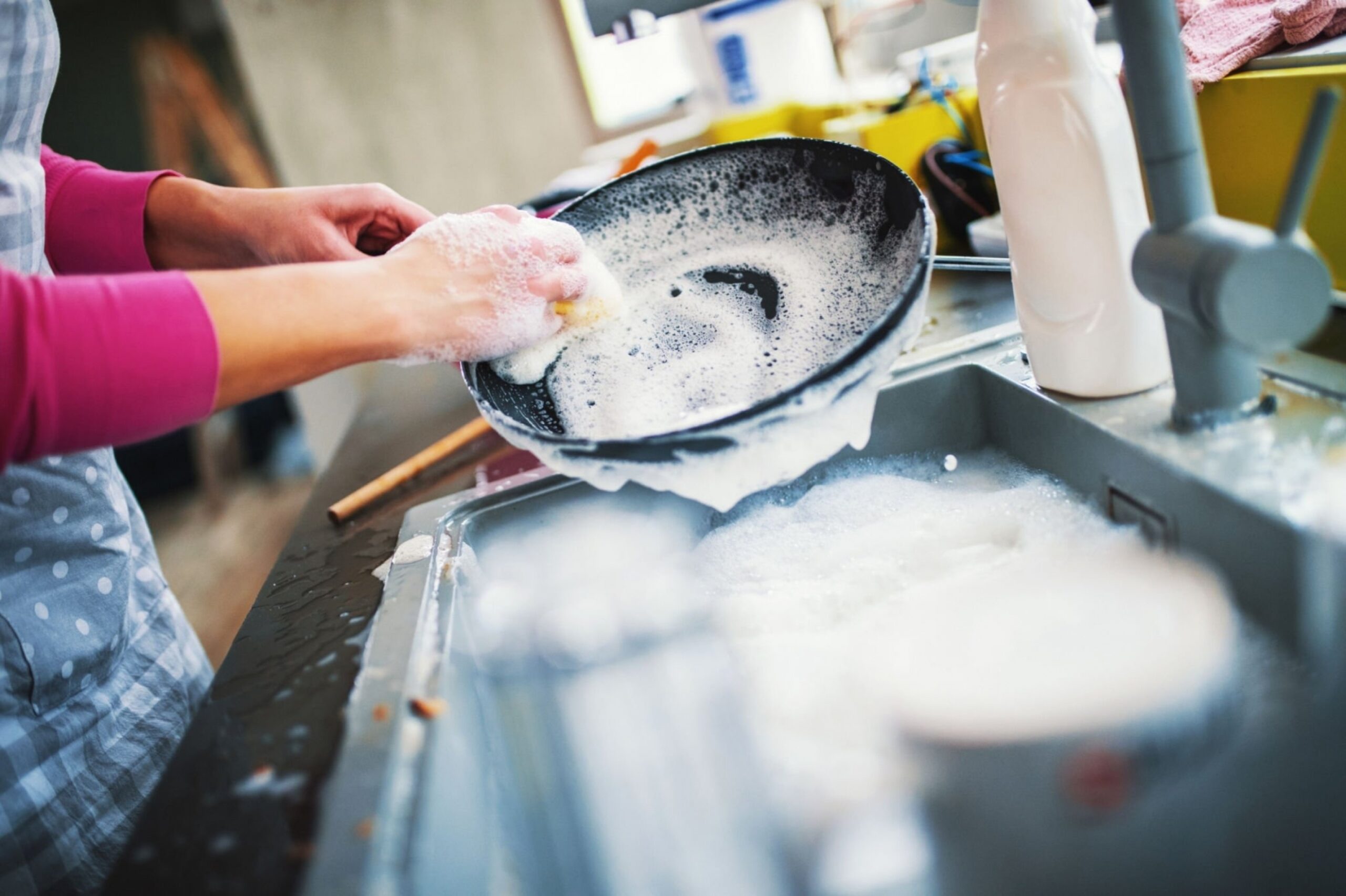
A lot of homes and families follow the “you cook, I’ll clean” rule in their kitchens, and this is definitely a beneficial habit. However, what many families with clean homes will tell you is that they actually clean while they cook, not after. Cleaning while you cook is the best way to eliminate stubborn stuck-on food, and you won’t even have to let anything soak in the sink.
Eliminate Junk Drawers
The presence of junk drawers within the home is a clear sign of chaos, so it is best to eradicate them once and for all. Clearing junk drawers is a great way to make sure everything in the home has a place and a function. Take some time to pay attention to what is found within the junk drawers and be mindful of how everything fits into the home.
Make a List and Keep it Visible
Making a mental note of tasks to handle throughout the day is a good way to stay motivated when cleaning, but it is not always the most efficient. One way to aid this is by writing down the to-do list and keeping it visible to everyone in the home. When every task is visible and can be physically crossed off, it can be easier to keep everyone motivated and accountable when cleaning.
Make Every Bed Everyday
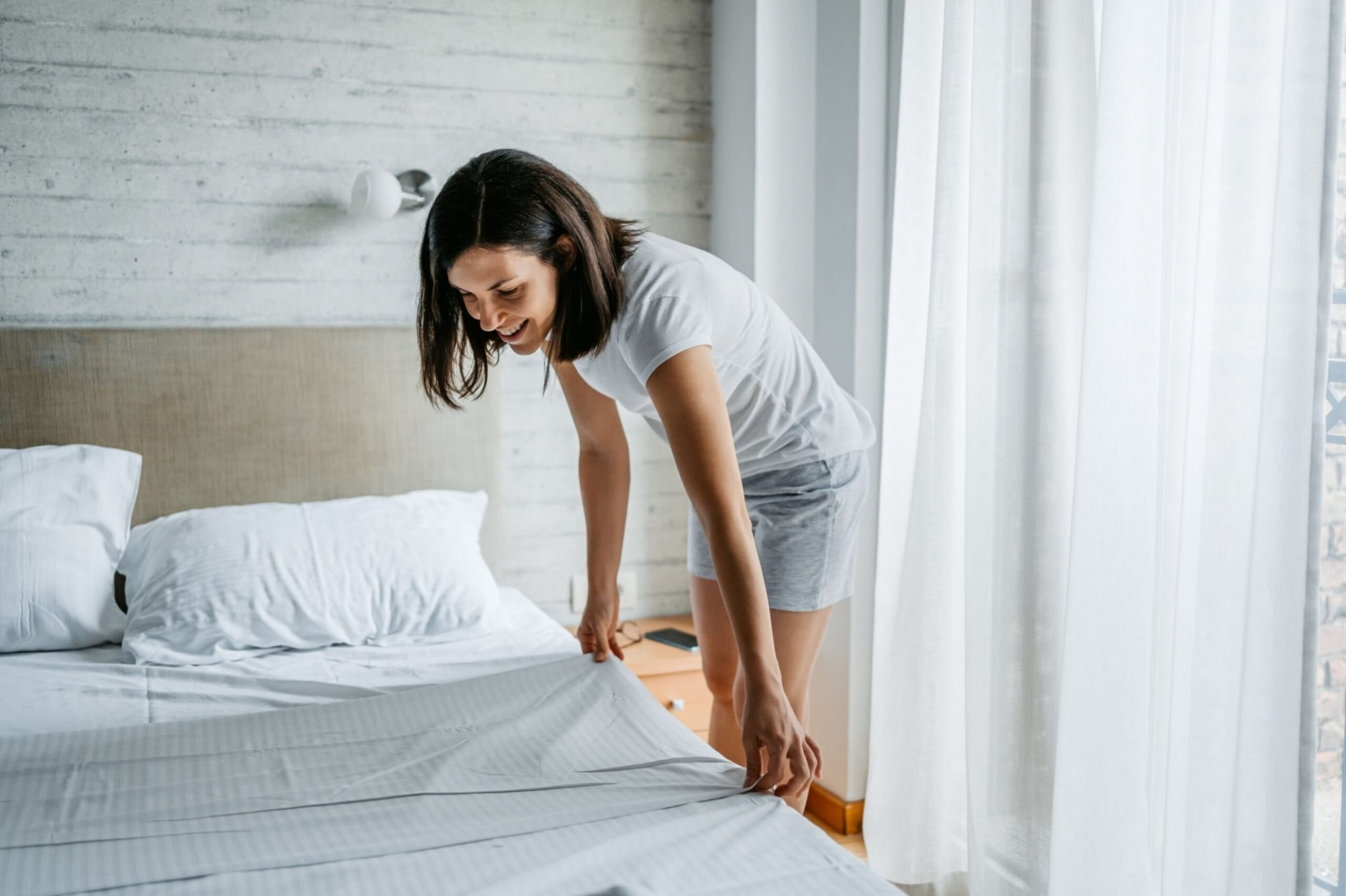
Making the bed every morning, like the “no shoes” rule, is one of the simplest habits to start within a clean home. The bed is the centerpiece of every bedroom so when it looks tidy, the rest of the room will follow its lead. Starting each day with a freshly made bed can lead to higher productivity as well as a more restful sleep each night.
Do a Quarterly Deep Clean
Everyone knows spring cleaning is a good habit to live by, but what about winter, fall, and summer cleaning? One of the most effective habits within clean homes is a quarterly deep clean and decluttering, especially as the seasons change so that clothing and seasonal decorations can be reviewed. This is one of the best ways to keep clutter under control within the home.
Have Designated Zones
Clean homes with pets and children seem unattainable, and yet they are possible. The best way to maintain order in a home is by creating and outlining specific areas for specific people or activities. It would be smart to keep your pet’s leashes and care items in one place and organized so that everything is within reach. Similarly, keeping kids’ toys and games organized and within a designated area can be a great way to keep little ones accountable.
Stay Ahead of Laundry Piles

While some homes with multiple family members can have laundry piling up on a daily basis, there are others that seem to always have neatly folded and fresh clothing at the ready. Daily or semi-daily laundry washes are a great way to keep clothes and linens fresh and organized around the home, as well as a good way to make sure the home always smells fresh.
Sweep, Vacuum, and Dust Daily
Floors easily accumulate dirt, dander, and debris throughout the week. By incorporating a regular sweeping, mopping, and vacuuming routine, the buildup is manageable. By having a regular dusting routine, there will be fewer allergens floating through the air of the home, making a noticeable impact on the overall health of family and pets. keeping the dust from Clean floors keep a home looking and feeling tidy and well-kept, so it is no secret that maintaining them can make a difference.
Choose One Room to Clean Each Week
Maintaining an already tidy home is far easier than maintaining a home that requires more extensive work. For homes that require that extra effort, a good way to get started with managing the mess is by choosing one room to focus on for the week. By fully decluttering and tidying the home room-by-room, the space can become both functional and easier to clean.
Keep Counters Clear
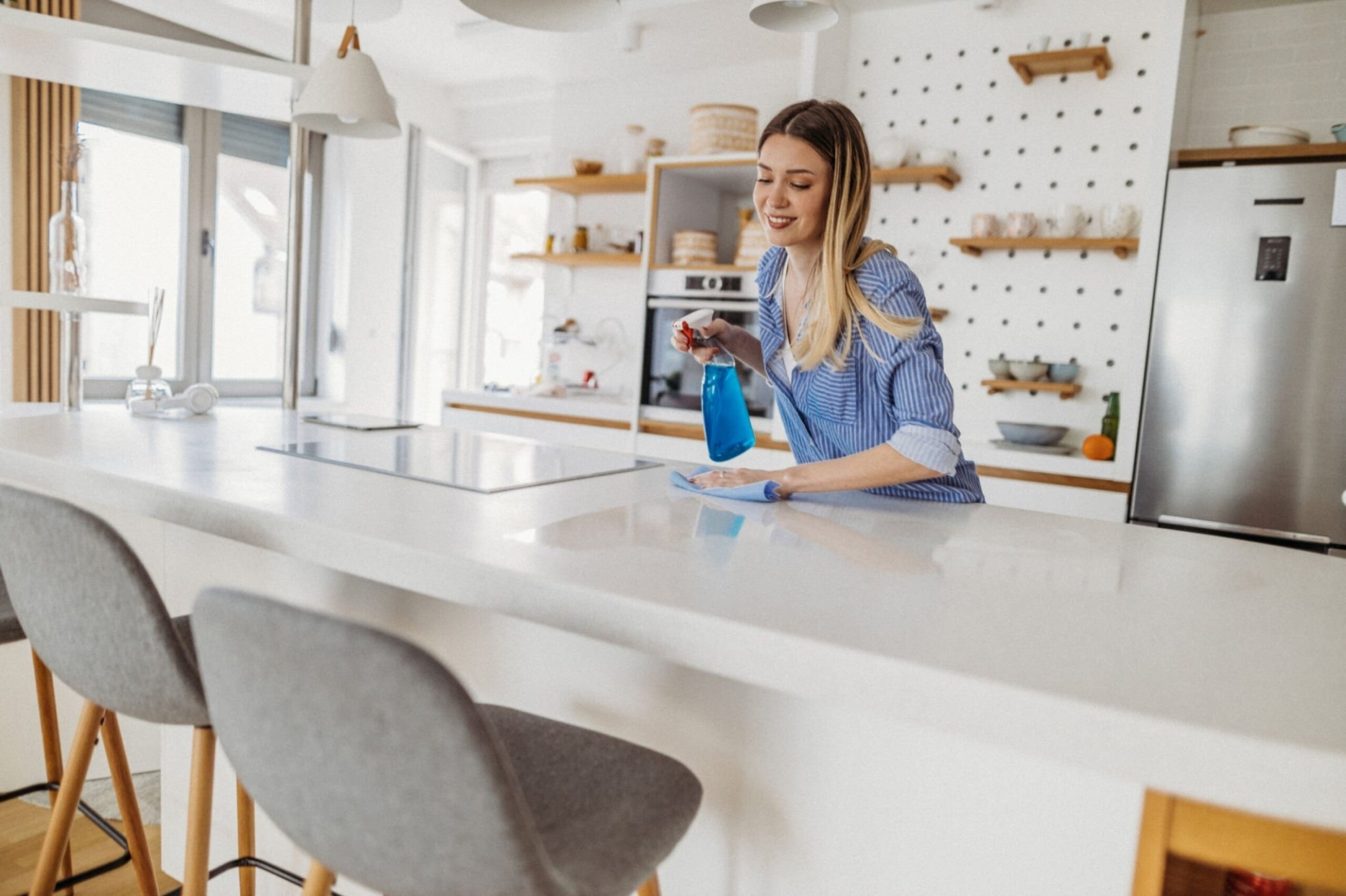
Countertops and other flat surfaces around the home are like magnets for random clutter throughout the week. However, clean homes seem to always have perfectly clear and clutter-free surfaces. Ensuring that everything has a place within bathrooms and kitchens and also taking that extra 5 minutes during the day to put everything where it belongs can make a huge difference in daily cleaning within the home.
Clean Showers After Every Use
Another easy and simple task that can be done to keep a home clean is wiping down and cleaning the showers after using them. Showers can get surprisingly filthy after just a few uses and who feels as clean as they should after using a dirty tub or shower? After showering, using a squeegee to remove the water can minimize any hard water or soap stains from the walls, especially within glass showers. Having a simple cleaning solution on hand to use in the shower is also a good way to stay on top of any stains.
Master the Art of Multitasking
Cleaning, tidying, and decluttering can all be time-consuming tasks that can take up more time in the day than planned. One of the best ways to accomplish more while cleaning is by multitasking. Much like cleaning while cooking, vacuuming while laundry washes, or making phone calls while doing the dishes can allow for more to be accomplished during the day. Listening to a podcast or audiobook is also a great way to pass time while completing mundane and boring tasks.
Keep Windows and Mirrors Clean
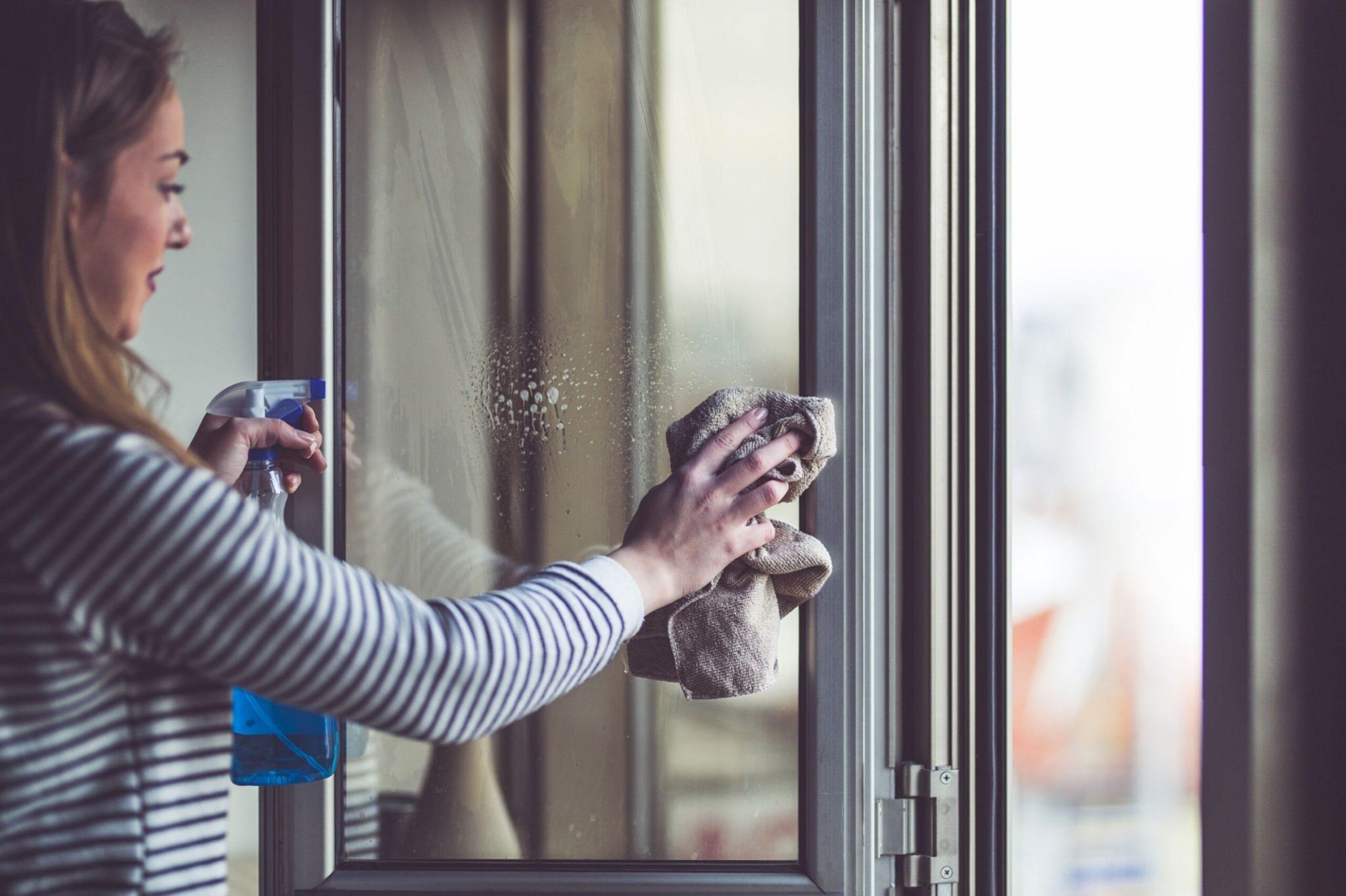
Glass surfaces and windows are magnets for dust and fingerprints to accumulate on throughout the week. One of the hallmarks of a truly clean and tidy home is well-maintained and shiny windows and mirrors. Incorporating a regular cleaning and polishing routine for any and all glass and other shiny surfaces is a great way to keep the home looking and feeling bright and fresh.
Know When to Let Go
Regular decluttering is one of the more complicated habits of clean home keepers, however, it can be one of the most effective. One of the biggest problems a home can have is an overabundance of unnecessary stuff. Cabinets, pantries, closets, and spare rooms can be full of clutter and junk. Making a habit of making regular donations or second-hand shop sales is a good way to minimize the clutter around the home.
Get Everyone Involved
Homes with several family members have the benefit of divided tasks. When multiple people are available to tackle the regular cleaning routine, the whole job can be accomplished quickly and efficiently so that everyone can move on to personal projects within a freshly tidied space. Families that work together to tackle the cleaning projects around the home can improve relationships as well as build valuable skills in organization and efficiency when working as a team.
Invest in Effective Products and Tools
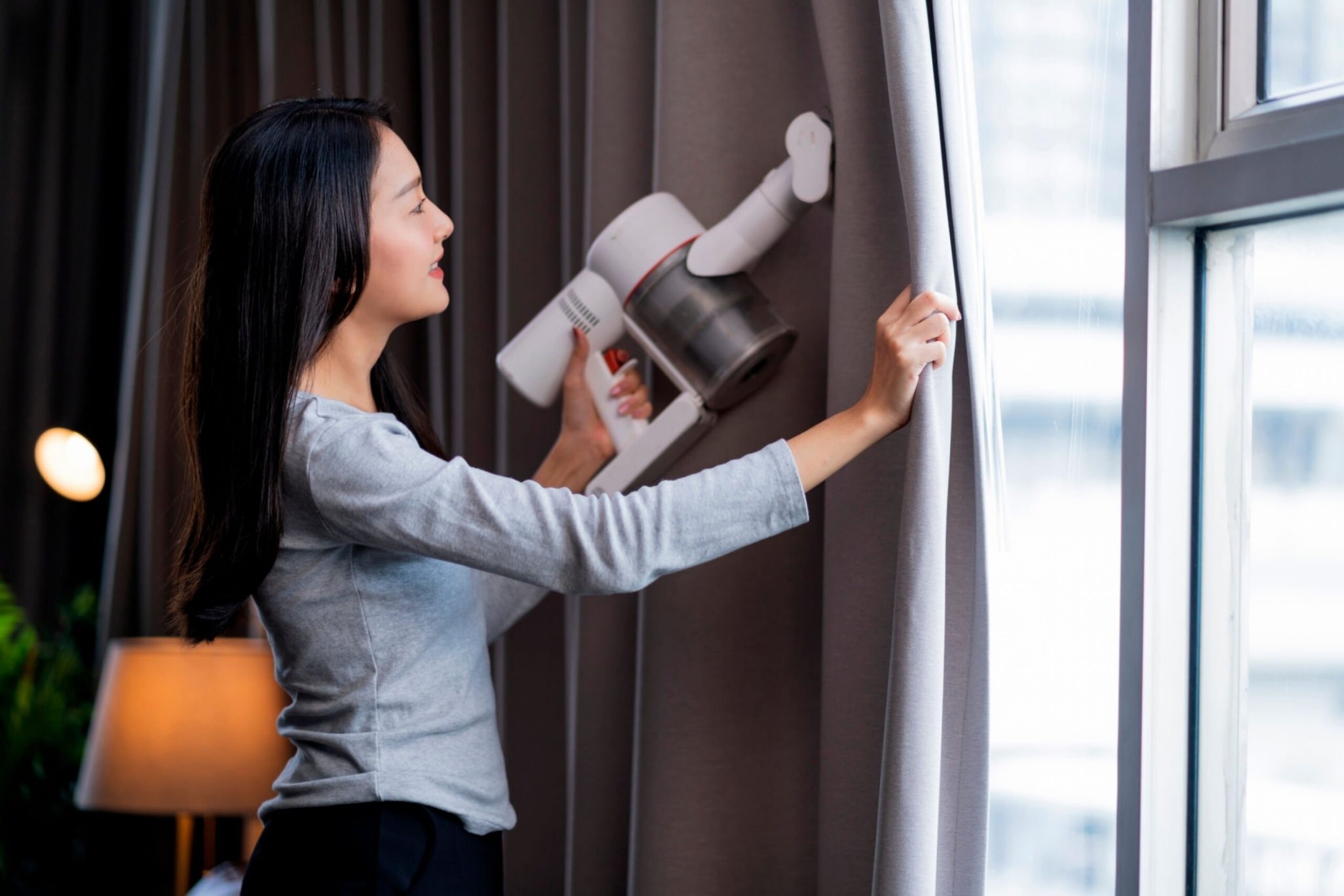
One of the best things about clean homes is the availability of high-quality cleaning tools and products. Investing in highly rated and efficient cleaning tools like high-end vacuums, carpet cleaners, and sweeper-mop devices can make a huge difference in the overall cleanliness of the home. Even investing in high-quality products can be the difference between having a streak-free mirror and not. Breaking the bank for top-rated cleaning supplies is not required, but budget options will not always garner the best results.
Keep Up with Grooming
Pets are considered beloved family members in most homes, so why not keep them just as clean and fresh as the rest of the family? Pets can bring in all kinds of dander and debris from their adventures outside, so a good habit to adopt in order to combat this is a regular grooming and care schedule. Don’t forget to brush and de-shed pets regularly to stay on top of dander around the home.
Disinfect Daily
Clean homes are often the healthiest homes, and that isn’t just because of eating or exercise habits. Homes that are tidy and clutter-free are easier to clean and keep clean, and this is especially true for surfaces and items that are used regularly. When everything is accessible, it is easier to disinfect and stop the spread of germs and bacteria around the home. A cleaner home is a great start to a healthier home.
Organize Behind Closed Doors

Even when a home appears clean and tidy, there can be hidden messes behind any door. Closets, pantries, and even refrigerators are easy to forget when cleaning and organizing because there is less of a need to make them appear tidy. One of the best habits of people with clean homes is going beyond the visible elements of the home and making sure that every aspect of the space is functional and organized.
What are the Benefits of a Clean Home?
You now have an arsenal of helpful habits and tips to use in your own home’s routine, you might wonder why you should incorporate them. The benefits of a clean home are vast but here are just a few of the best reasons to keep your home as clean and tidy as possible:
- Cleaner air and surfaces can minimize allergies as well as lessen the spread of harmful germs and bacteria around the home.
- When the whole family works together to accomplish the cleaning goals around the house, you’ll notice how well everyone can get along and work as a team. By the time your home is clean, you’ll have more time and energy for your family and friends.
- Clean and tidy surroundings are a guaranteed way to reduce stress and anxiety, who wouldn’t feel more relaxed in a clutter-free home?
- When you’re less stressed, you’ll get better sleep and feel more rested and productive each morning.
- The feeling of having accomplished something as huge as fully cleaning and completely decluttering your home is incomparable, so once it’s all done you’ll have a reason to celebrate and reward yourself.
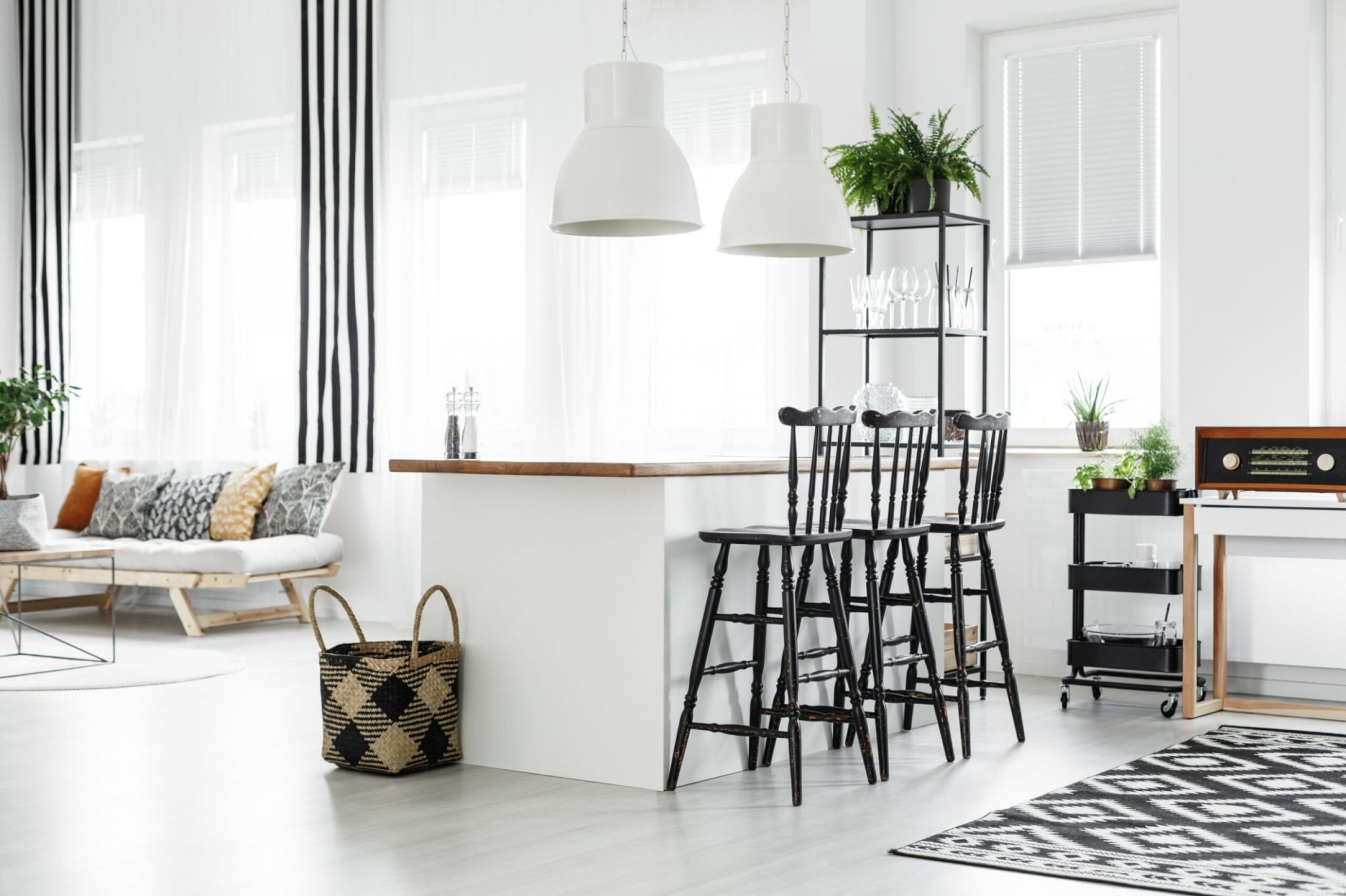
There is just one last secret to let you in on for keeping a clean home: You can ask for help when you need it. Hiring a cleaning service can take a huge weight off your shoulders especially if you find yourself without the time or energy to take on cleaning your home yourself. There is no harm or shame in calling in a professional service to help you deep clean or even get organized and declutter. Our team of friendly and professional cleaners are here to help you, so check out Cleanzen cleaning services in Miami. You can contact us to schedule a consultation or even just ask some questions, we would love to get you started on your home’s cleaning journey. What kind of tips and tricks do you use to keep your home clean and tidy? Share your secrets in the comments, we’d love to hear from you!
The post 20 Habits for a Clean Home appeared first on Cleanzen.
from Cleanzen https://cleanzen.com/blog/clean-home-habits/
via IFTTTfrom Cleanzen Cleaning Services https://cleanzencleaningservices0.blogspot.com/2023/01/20-habits-for-clean-home.html
via IFTTTfrom
https://cleanzencleaningservices0.wordpress.com/2023/01/25/20-habits-for-a-clean-home/from Gabriela Bragg https://gabrielabragg.blogspot.com/2023/01/20-habits-for-clean-home.html
via IFTTT -
Why Do Range Hood Filters Need to Be Cleaned?
Our kitchen’s range hood filter can often be forgotten during regular cleaning schedules. It happens to the best of us, don’t worry. With regular cleaning and just a few minutes out of your schedule, your range hood filter will not only look better but also be able to work properly and efficiently. Did you know that without running your rangehood properly, food debris, grease, and oils can build up on your counters, cabinets, and floors? Gross! Who wants all that around their food and family? Here is a helpful cleaning guide you can use the next time your range hood needs a good scrub.
How to Properly Clean Your Range Hood Filter
Range hood filters are pretty important to our kitchens and to our homes. While the fan is there to pull the cooking odors from the air, the filter is able to catch grease, smoke, and any harmful chemicals and remove them from the air. However, the filter can’t do its job properly or effectively if it becomes clogged with all that debris and build-up. If the air in your home and in your kitchen when you cook seems to linger and stay stagnant when you cook, even when the range hood fan is blowing, that’s a sign that the filter might be overdue for a good washing. An important thing to note is that a clogged and greasy range hood filter can more easily lead to a potential fire within the range hood and duct. Remember to check the state of your range hood’s filter often, so that your filter can do its job efficiently and keep the air around your kitchen clean and odor-free.
Getting Started
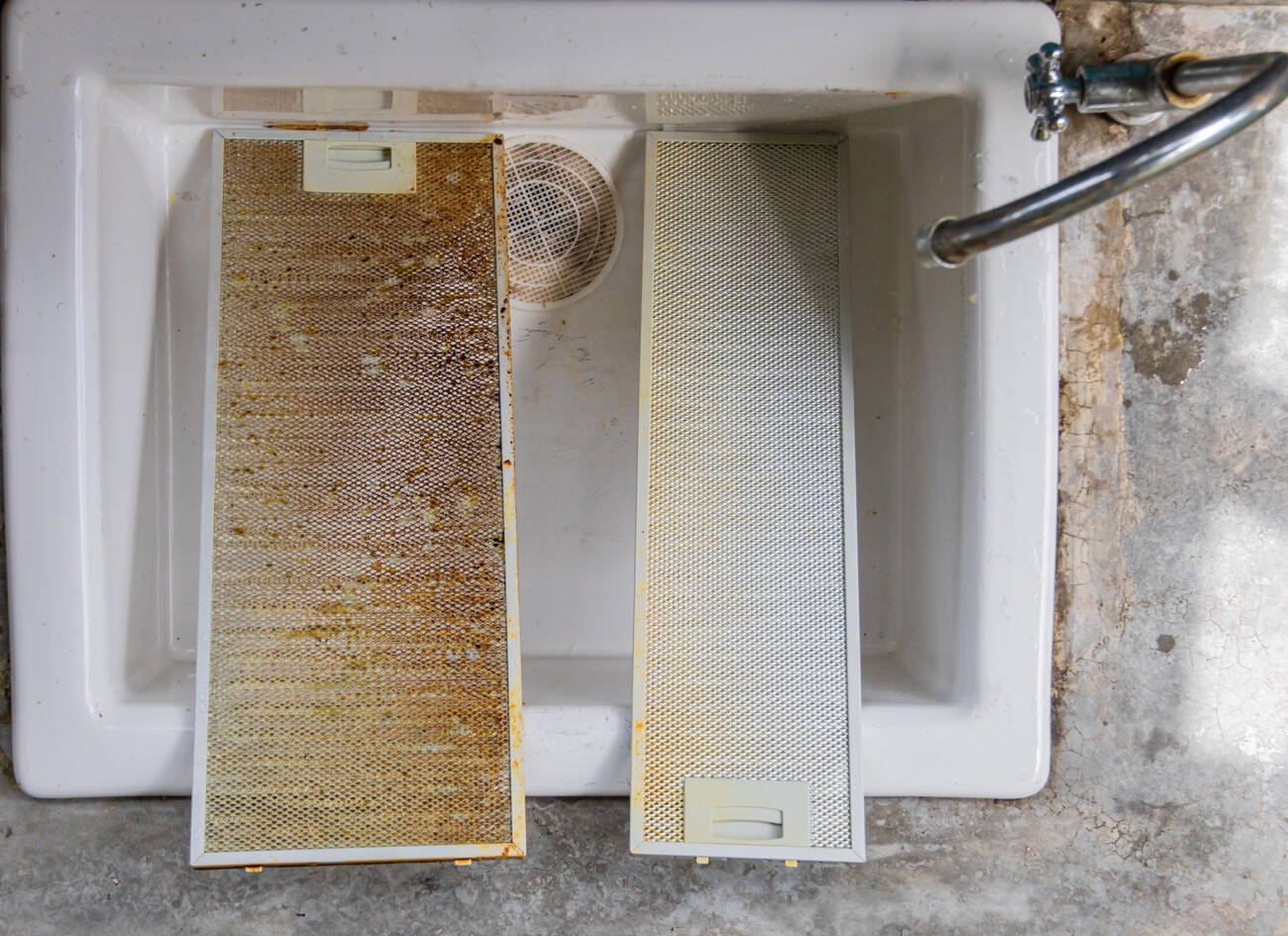
Before you start, there are a few things you’ll want to gather the supplies you’ll need for cleaning the filter properly. While many of these items are optional, they will certainly come in handy for a few of our favorite cleaning methods. You’ll need the following:
- Hot water
- Degreasing dish soap (be sure that your soap doesn’t contain any harsh chemicals or bleach as these will damage the finish of the filter)
- Baking soda (optional)
- Ammonia (optional)
- Sponge or scrub brush (don’t use anything course to prevent scratches)
- Soft towel
- Stainless steel cleaning spray or wipes (optional)
You’ll also need to know what kind of range hood filter you have so that it can be cleaned properly. One of the most common filters is a baffle filter which is usually made of stainless steel. Another popular filter style is a mesh filter, which can be stainless steel or aluminum. Both of these filters are safe to clean in the dishwasher. However, if you have a ductless range hood, you may have a charcoal range hood filter. These charcoal filters cannot be cleaned and must be replaced every 3 to 6 months, making them less cost-effective than the baffle or mesh style filters.
Many Ways to Clean

Clean in the Dishwasher:
We mentioned that baffle and mesh filters can be cleaned in the dishwasher. While this is the most simple way to clean them, there is still a proper way to do so. Here is the best way to clean these filters using your dishwasher:- Remove the range hood filter and rinse it with warm water to loosen the grease.
- Wipe off the filter before placing it on the bottom rack of your dishwasher.
- Run a regular cleaning cycle and check the state of the filter following the end of the cycle.
- Repeat the cleaning cycle if necessary. It is normal to have to run the cycle a few times to fully clean the filter.
- Once the filter is clean, wipe it dry. If your filter is stainless steel, remember to wipe the filter following the grain so that you aren’t damaging the finish.
If your range hood is in need of some more intense cleaning and TLC, don’t stress. While this first method isn’t much, it will get you the results you’re looking for. Here are some more in-depth cleaning methods for cleaning your range hood filter:
Method 1:
- Start by filling your sink halfway with hot water and a couple of drops of dish soap
- Remove the filter from the range hood and place it in the sink
- Allow the filter to soak in the hot soapy water for about 20 minutes, flip the filter if necessary halfway through
- Use a sponge or scrub brush to lightly scrub away the loosened debris and grease clogs
- Thoroughly rinse the filter with clean hot water so that there is no residue left over
- Dry the filter completely with a soft towel before replacing the filter in the range hood
Method 2:
- Fill your sink half full with the hottest water possible then add a few drops of dish soap as well as ½ cup of baking soda and mix it all thoroughly.
- Remove the filter from your range hood and place it in the sink so that at least one side is completely submerged and allow the filter to soak for 10 to 15 minutes
- Flip the filter if necessary and allow the other side to soak for another 10 or 15 minutes
- Use the sponge or scrub brush to remove the grease and debris from both sides of the filter, and wear gloves so that your hands are protected from the hot water and metal.
- Drain the sink and rinse the filter thoroughly with hot water to remove any remaining debris.
- Use a soft towel to dry the filter thoroughly before placing the filter back in the range hood.
Method 3:
This method is best for mesh range hood filters, and filters that perhaps haven’t been cleaned very often in the past. As this method uses strong and odorous chemicals, be sure to use this method carefully and in a well-ventilated area away from children and pets, or even completely outside where it will not be disturbed.
- Depending on the size of the filter, fill a sealable plastic bag or trash bag with a small amount of ammonia.
- Remove the range hood filter carefully and place it into the ammonia-filled bag to soak.
- Close the bag and allow the filter to soak in the ammonia for a few hours or overnight.
- Open the bag after it has finished soaking and, keeping it away from your face and nose, remove the filter.
- Rinse the filter thoroughly in the sink with warm water and use a microfiber towel to dry it
- Allow the filter to dry completely before putting it back in the range hood
How to Degrease the Filter:
If you find your range hood to be particularly greasy and clogged, it can be a pain to clean it. Before you use any of the previous cleaning methods, try this quick and easy degreasing method:
- Mix together a paste made from a ratio of 3 to 1 baking soda and water.
- Set your range hood filter on a flat surface and apply a generous amount of the past to the surface, with heavier application on the greasiest spots.
- Allow the paste to sit on the surface of the filter for around 20 to 25 minutes.
- Wipe the paste from the range hood filter with a wet cloth and rinse it well.
- Follow a regular cleaning process before rinsing and drying the filter as thoroughly as possible.
Remember to also take some time to clean the exterior of your range hood so that both the interior and exterior are spotless and ready for your next culinary creations.
How Often Do Filters Need Cleaning?

One of the most important things to remember is how often your range hood filter should be cleaned. The filter should be cleaned about once a month, especially if you use the range hood often during cooking or have been cooking particularly greasy or oily foods. The frequency of cleaning will almost certainly vary between households, so be sure to check the state of your filter more often. If your range hood uses a charcoal filter, remember that it should be replaced every 4 or 5 months, or after about 120 hours of cooking. One tip we often share is to deep clean your range hood filter, no matter what state it may be in, right before preparing any large meals like holidays or parties. This way you’ll have the best results with your meal, and no unpleasant lingering odors disturb guests.
Have you used any of these tips to clean your range hood filter? What kind of tips and tricks can you share that have worked for you? Tell us in the comments, we love hearing from our customers. Do you need a little extra help around the house? Check out our official site to find out how we can help you. We’re more than happy to help you keep your home looking clean and tidy. Contact us today!
The post Why Do Range Hood Filters Need to Be Cleaned? appeared first on Cleanzen.
from Cleanzen https://cleanzen.com/blog/how-to-clean-range-hood-filter/
via IFTTTfrom Cleanzen Cleaning Services https://cleanzencleaningservices0.blogspot.com/2023/01/why-do-range-hood-filters-need-to-be.html
via IFTTTfrom Gabriela Bragg https://gabrielabragg.blogspot.com/2023/01/why-do-range-hood-filters-need-to-be.html
via IFTTT -
The Ultimate Checklist for Cleaning the Kitchen
Keeping your kitchen clean is a job that can seem overwhelming if not kept up with. Clutter can easily overrun your counters and your dishes can pile up in the sink and begin to smell if not dealt with soon enough. The last thing you want to see in your kitchen while you cook is flies or other bugs around your food. To help you stay motivated and accountable when cleaning your kitchen here is a handy checklist you can follow and incorporate into your regular cleaning schedule.
Why is A Clean Kitchen So Important?
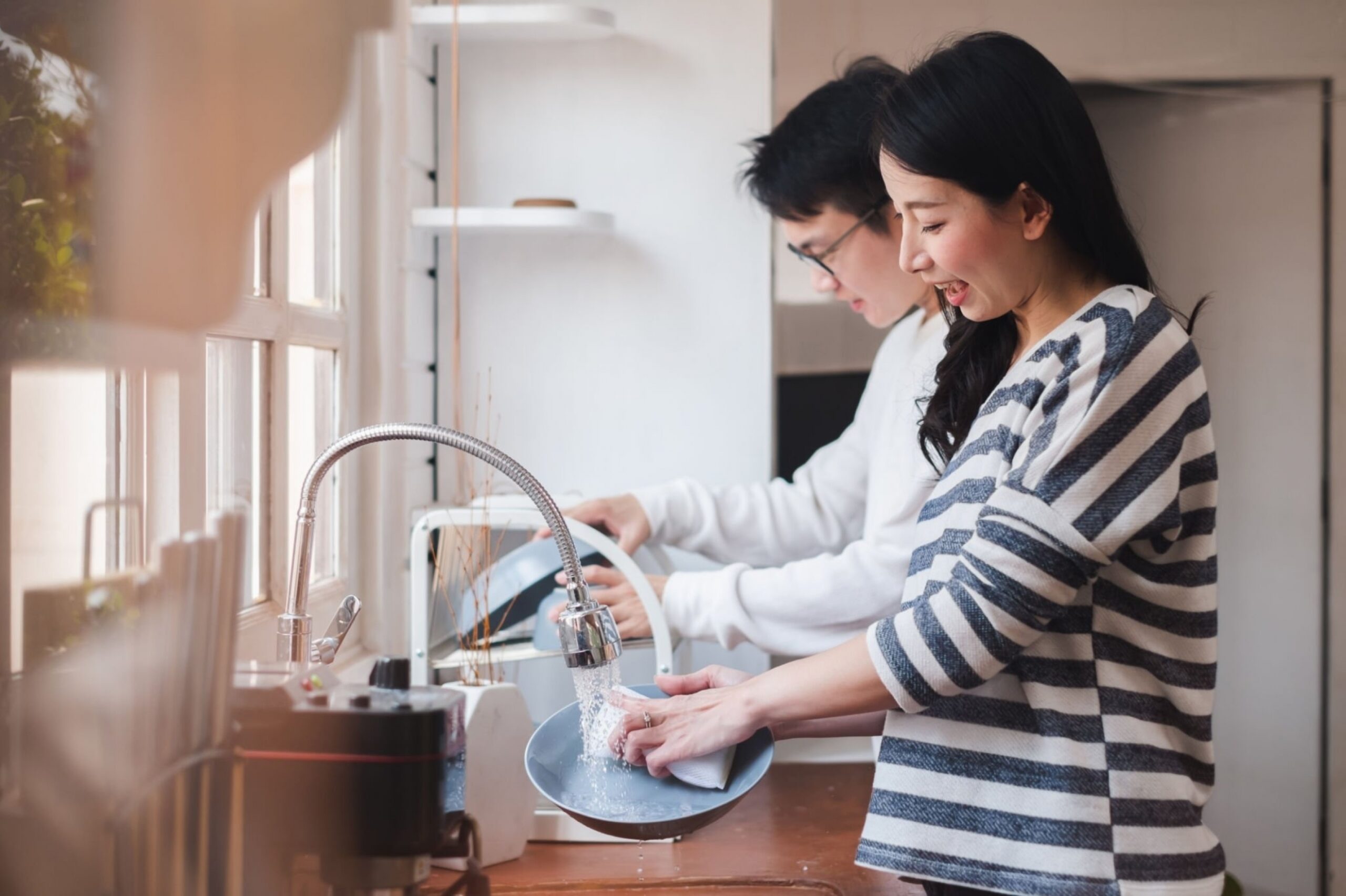
Keeping your kitchen clean and tidy can be a constant battle and it can be discouraging to see it in a poor state before cleaning. So why should you keep up with cleaning it regularly if it’s such an uncomfortable task? Consider all the grease and grime built up around your sink, oven, and microwave, and think about how much bacteria and germs can build up on these surfaces. Cooking surfaces need to be kept clean and disinfected on a regular basis in order to avoid spreading those germs and bacteria to your and your loved ones’ food. On top of this, remember that your kitchen is the center of your home. A clean and tidy kitchen can easily motivate you to keep the rest of your home looking just as well-kept and inviting.
Start With The Daily Basics

There are a handful of cleaning tasks you can complete daily in order to stay on top of any basic messes and clutter. Daily cleaning can keep you and your family motivated to keep the rest of the home clean as well. Here are the daily cleaning tasks:
- Wipe down your counters and stovetop
- Sweep the floors free of crumbs and debris
- Do the dishes and put them away
- Clean the sink of any food debris
- Put everything where it is meant to be
- Disinfect high-touch surfaces
The Weekly Nitty Gritty
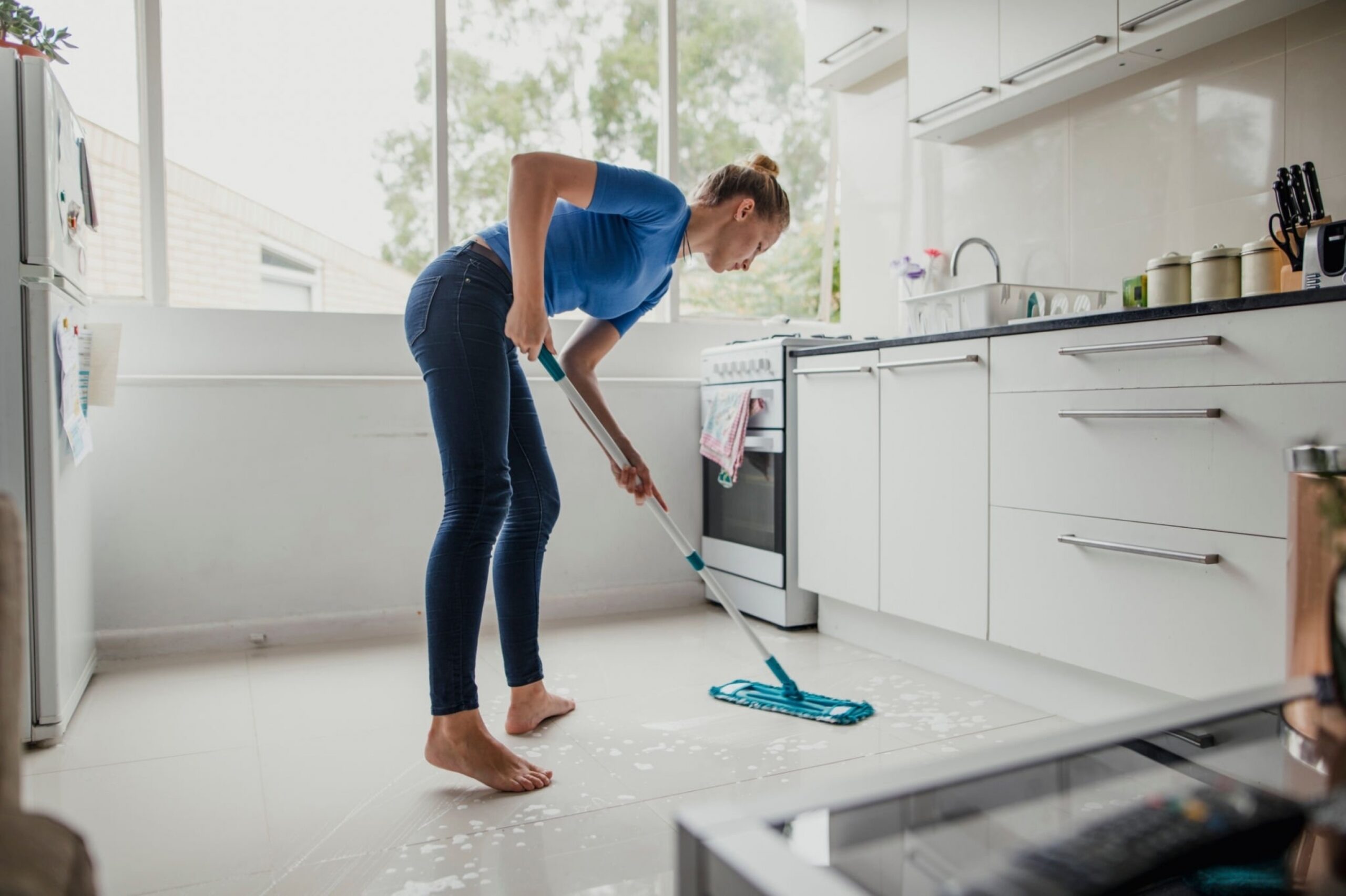
Once a week, you can tackle a set of more thorough tasks so that you have a fresh start before each week. These won’t need to be done more than once or twice each week but they can make a huge difference. Here are your weekly cleaning tasks :
- Mop the floors
- Take out the trash
- Wipe down the exteriors of your appliances
- Clean your sink’s disposal
- Check for any leftovers that have gone bad
- Wipe your cabinets
- Wash the dish towels
Deep Clean Monthly
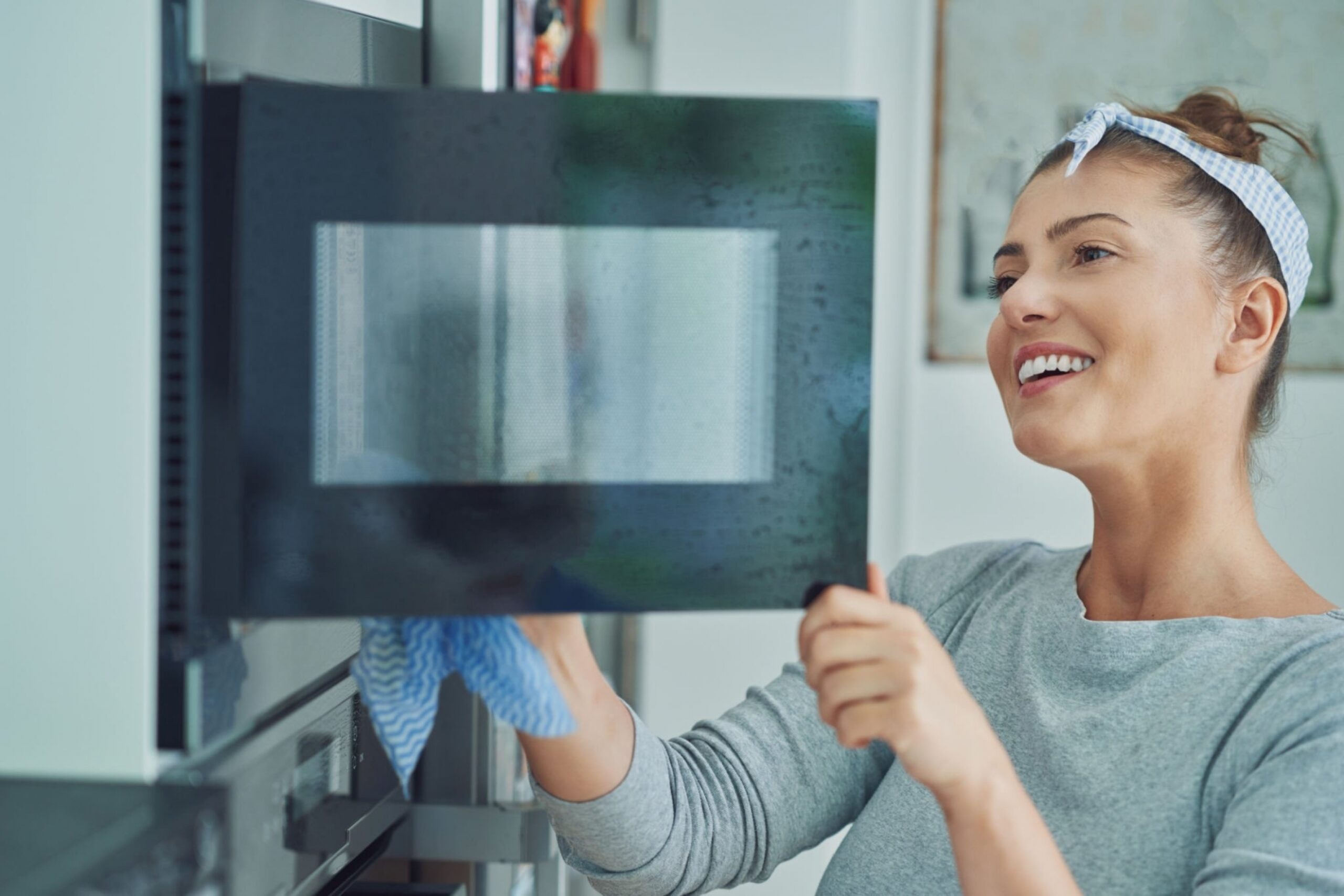
Each month, make sure you complete the more tedious tasks so that there is no buildup or clutter left around the kitchen. While these tasks may take longer, you’ll only need to complete them every few weeks to keep your kitchen looking good. Here are the monthly tasks you should accomplish:
- Check your pantry for expired foods
- Clean appliance interiors
- Sanitize the sponges
- Dust above the cabinets and refrigerator
- Declutter your refrigerator and freezer
- Clean and sanitize the trash bin
- Clean the dishwasher
- Clean your coffee maker
- Wash any rugs
- Clean the interior of your refrigerator
- Declutter your pots, pans, dishes, cups, and Tupperware
Between The Cleaning

Our kitchens are the heart of our homes and one of the most used spaces during our daily lives. It is important to keep yours tidy and welcoming each time you use it. As you check your tasks off each day, you’ll start to notice how much a little cleaning can go a long way. In order to best stay ahead of your more tedious and time-consuming tasks, here are a few tips and tricks for managing messes:
- Have a visual checklist to keep track of completed tasks and stay motivated to keep your space free of germs and food crumbs.
- Make sure to thoroughly clean up any spills so that there’s no sticky residue left behind for you to deal with later.
- When you declutter your pantry, refrigerator, and freezer make sure that you remove everything so that you can fully assess what needs to be thrown out, what you have, and what you need.
- Keep your multipurpose cleaner in an easily accessible place so that you can get to it quickly.
- Sweep after each meal so that you always start fresh.
- If you live with your family, delegate some of the more time-consuming tasks so that everyone can help keep the kitchen tidy.
What does your kitchen look like after keeping up with this checklist? Do you have any tasks you added to your checklist? Tell us about them in the comments! If you’ve been struggling to keep your kitchen tidy, but can’t seem to find the time you need to clean up during your week, that’s okay. We’re here to help. Our house cleaners Houston have a variety of services that can help you whip your kitchen into shape and keep it that way. Contact us today to find out how we can help you get your home looking and feeling its best!
The post The Ultimate Checklist for Cleaning the Kitchen appeared first on Cleanzen.
from Cleanzen https://cleanzen.com/blog/kitchen-cleaning-checklist/
via IFTTTfrom Cleanzen Cleaning Services https://cleanzencleaningservices0.blogspot.com/2023/01/the-ultimate-checklist-for-cleaning.html
via IFTTTfrom Gabriela Bragg https://gabrielabragg.blogspot.com/2023/01/the-ultimate-checklist-for-cleaning.html
via IFTTT -
Smart Ways to Keep Your Small Apartment Organized
Small apartments can be really difficult to keep tidy and organized, especially when there is very little storage available. Here are a few ways you can maximize storage in your minimally sized living space.
Kitchen
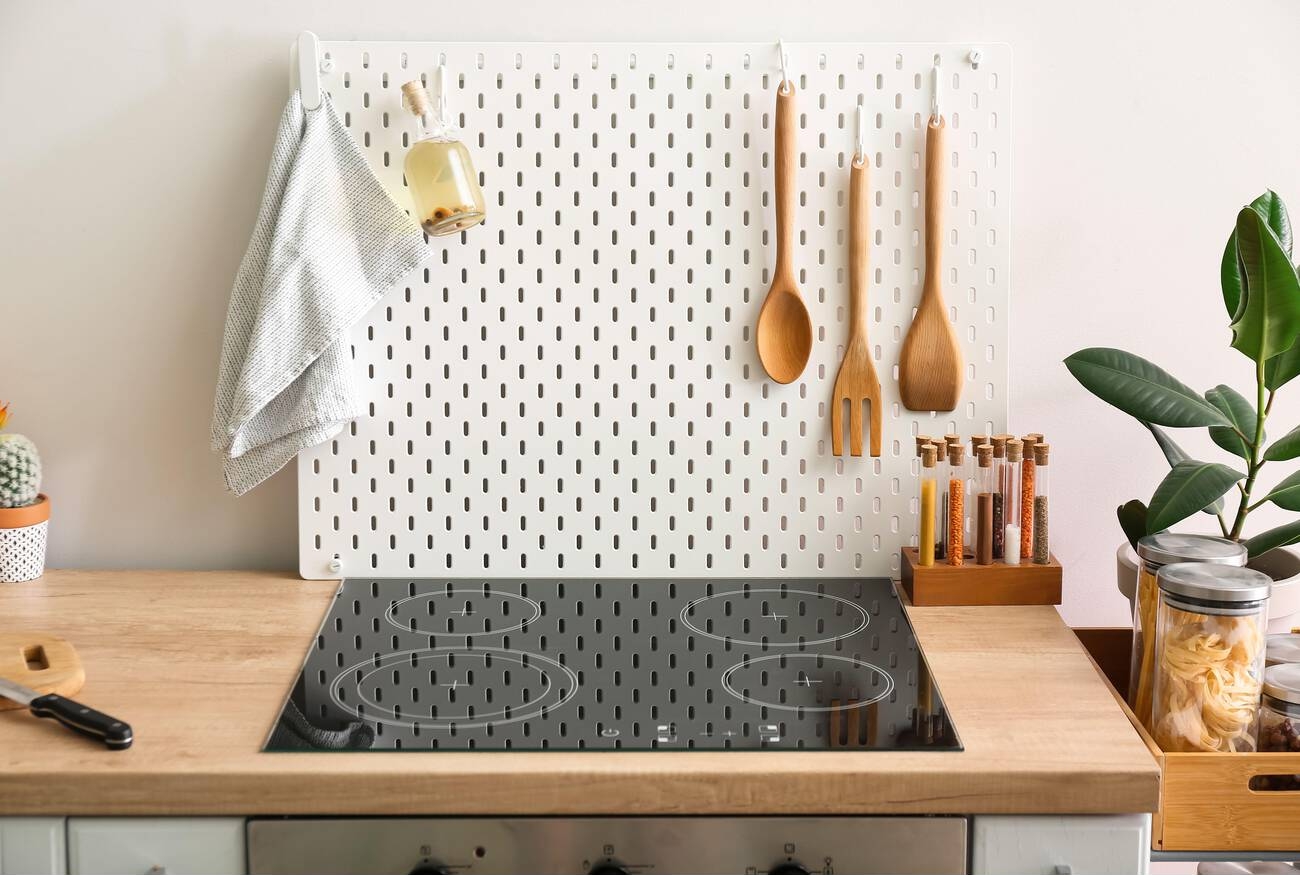
- Collapsable Drying Rack: Keeping a drying rack on your kitchen counter at all times minimizes the amount of space you have to use when cooking. Consider looking for a collapsable or roll-up drying rack that you can tuck under the counter when you’re not using it to save space.
- Thin-Space Rolling Cart: You’ll want to utilize as much space in your kitsch as possible, including any space between cabinets and appliances or walls. There are rolling carts that fit in these tight spaces that can be perfect for extra storage outside of cabinets.
- Magnetic Storage on the Fridge: The space on your fridge usually reserved for decorative magnets can easily turn into a storage solution with the right products. Check out some magnetic shelving or bins to put on the side of your refrigerator if it isn’t against the wall.
- Mounted Peg Board Storage: If cabinets and drawers are unavailable for storage, look to the walls for some extra space. You can mount a peg board and keep your favorite pots and pans readily available but out of the way.
Bathroom
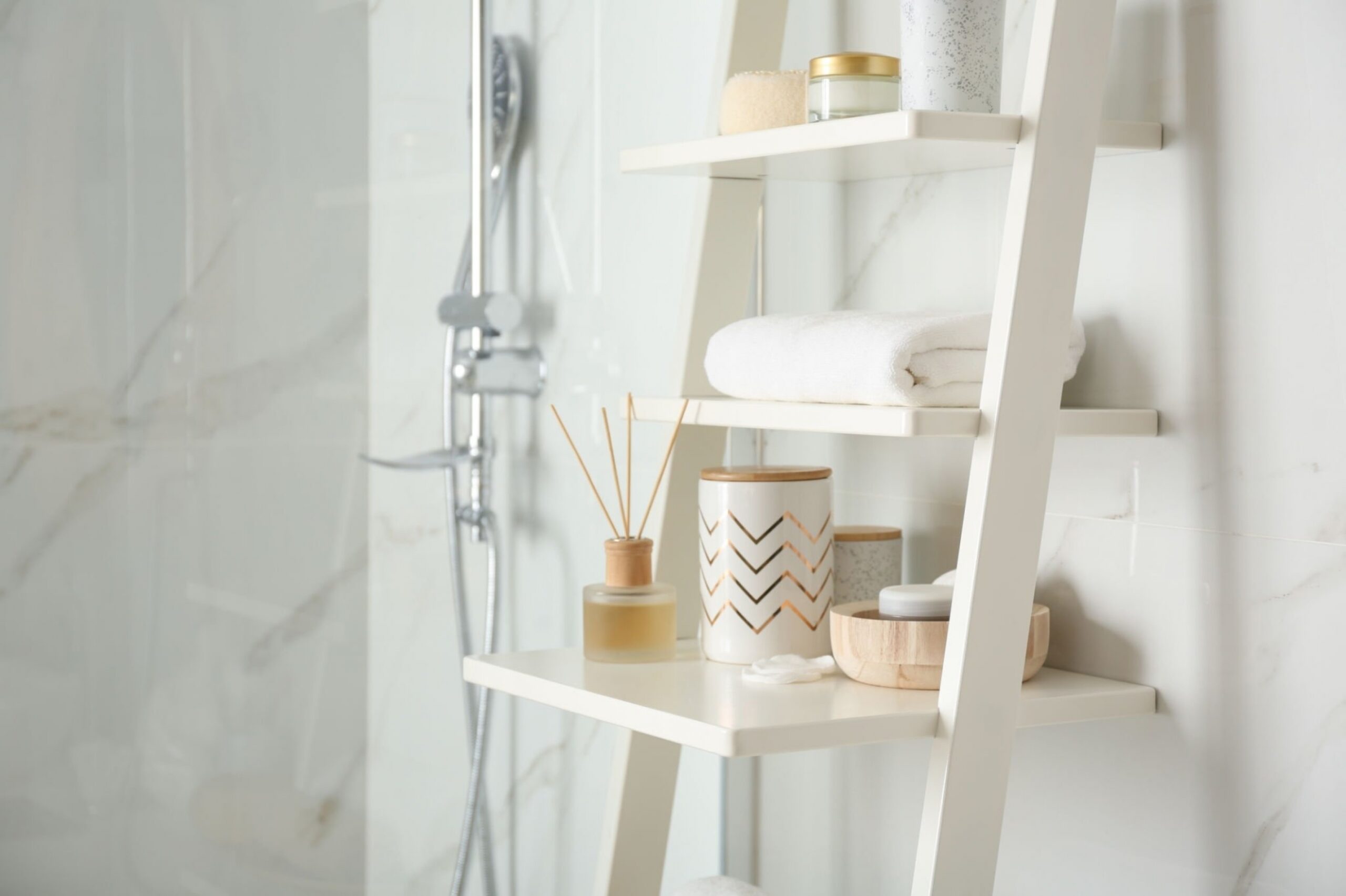
- Wall-Mounted Storage/ Medicine Cabinets: If your bathroom is lacking in under-the-sink storage and counter space, try adding your own storage. Adding a medicine cabinet or shelves by the sink and over the toilet is a great way to maximize the vertical space in the bathroom.
- Stackable Drawers/ Bins Under the Sink: The space under the bathroom sink shouldn’t be overlooked. Picking up some functional drawers or stackable bins to keep in this area can save you some much-needed counter space.
- Shower Shelves/ Caddies: We all need our go-to shower products accessible for daily use. There are a lot of different in-shower storage options to choose from including caddies, shelves, and even shower liners with pockets.
- Mounted Hooks for Towels: Towel racks are often unavailable in smaller apartments, but you won’t want to mount one only to have it take up more space than you can spare in the bathroom. Mounting some hooks near the shower or on the bathroom door to hang your towels is a great way to save wall space for more functional storage.
Bedroom

- Murphy Bed: These are a great way to maximize the space in your bedroom, especially if you happen to live in an open studio-style apartment. Folding your bed away to make room for a desk or dining table is a cool way to keep your space functional and clutter-free.
- Under-the-Bed Storage: If a Murphy bed is too much of an investment for a temporary living situation, make sure you still make the most of the space you have. Under-the-bed storage drawers or bins are a great way to keep clutter off the floor and make room in the closet for seasonal clothing.
- Over-the-Door Closet Storage: If your closet has become overrun with shoes or bags, it may be time to look into some storage options. Over-the-door hooks or caddies are a smart way to keep shoes or other accessories organized and out of the way.
- Uniform Hangers: If your closet contains a multitude of mismatched hangers, switching them out for a full set of uniform hangers can make a huge difference. For smaller closets, you can even find sets of stackable hangers to minimize the space your clothing takes up on the racks.
Living Room
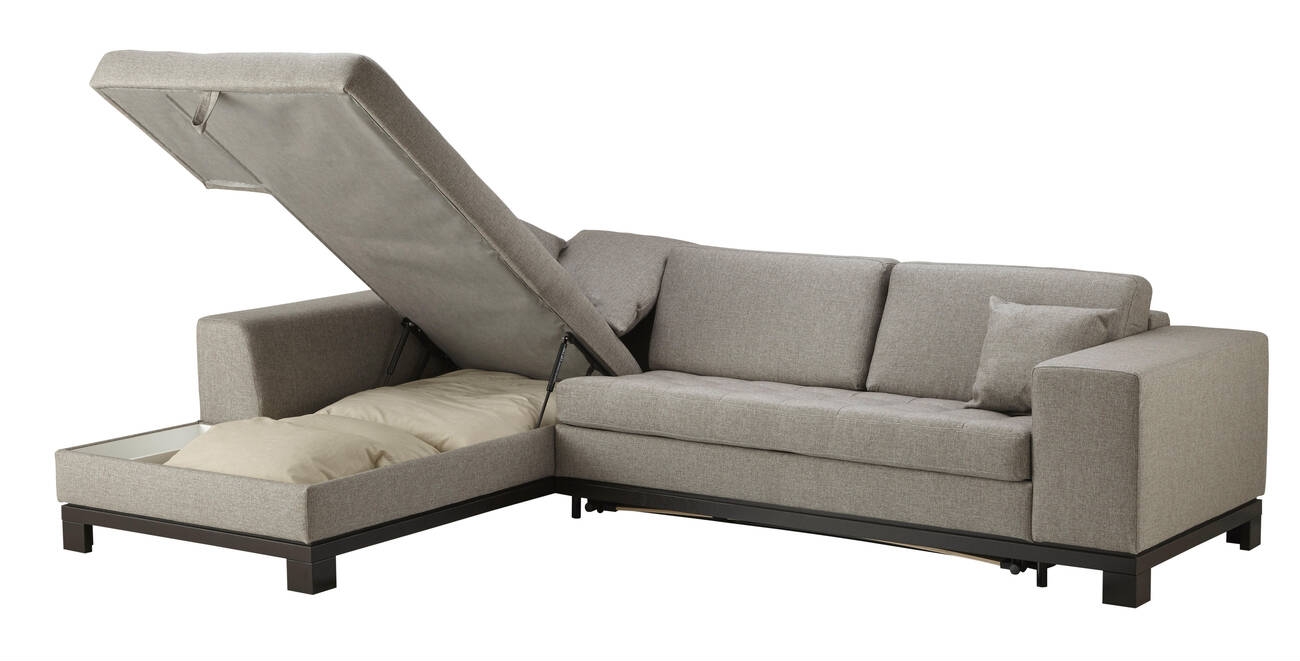
- Wall-Mounted Storage Shelves: As with all small spaces, vertical storage is a must. We highly recommend investing in some sturdy and stylish shelving for your living room if you find yourself searching for space.
- Multi-Functional Storage Furniture: Sofas, coffee tables, and entertainment centers can take up tons of space in any living room. Make the most of these huge pieces by finding furniture with built-in storage solutions so you can keep extra blankets and board games tucked away for future use.
- Cabinets/ Hidden Storage Spaces: If your living room has the space, consider adding some storage cabinets or drawers. Having stylish but functional storage to keep things hidden and tidy can both elevate the appearance of the space and give you more storage for organization.
- Coordinated Storage Decor: Having a random assortment of bins that are different colors and sizes can make a space look and feel more cluttered than it is. A uniformly sized and color-coordinated set of bins can keep things organized and look great in an open storage space.
How have you kept your small apartment organized? Tell us in the comments and share your tips and tricks! If you need some help decluttering your small space, check out our Home Organization services at www.cleanzen.com/Philadelphia. We have a variety of services for any of your cleaning or tidying needs.
The post Smart Ways to Keep Your Small Apartment Organized appeared first on Cleanzen.
from Cleanzen https://cleanzen.com/blog/smart-ways-to-keep-your-small-apartment-organized/
via IFTTTfrom Cleanzen Cleaning Services https://cleanzencleaningservices0.blogspot.com/2022/12/smart-ways-to-keep-your-small-apartment.html
via IFTTTfrom Gabriela Bragg https://gabrielabragg.blogspot.com/2022/12/smart-ways-to-keep-your-small-apartment.html
via IFTTT
Skip to content
